Welcome to my “Australia Road Trip 2016 – Tasmania phase”. This photographic road trip was organised by Jetabout Holidays (Holiday Tours and Travel) in collaboration with Tourism Australia covering both Sydney and Tasmania, which totalled 2 weeks from 2-18 Nov (2 Nov being a departure date with 8 hours direct flight to Sydney via Qantas), with an estimated driving mileage of some 3000km. This travelogue is in continuation from the Sydney and NSW leg, with the Tasmania phase which commenced on 10 Nov 2016, as we landed at 2100hrs in Hobart on 9 Nov 2016. The Tasmania segment presented a more laid-back ambience with a wide vista of natural landscapes and fresh seafood that Tasmania is renowned for. Travellers on self-drive will experience stunning natural scenery along the scenic routes.
As some remote parts will be out of reach to GPS connectivity, a printed route map will still come in handy. Quite a few of my friends thought of the great wilderness of Tasmania as being “boring with nothing much to do”. This is definitely quite the opposite as the island is simply spectacular and even surreal. If you like Hokkaido, then Tasmania will not disappoint you. In my humble opinion, as long as you have a great travelling companion, it will be an enjoyable adventure. In this phase of the road trip, I will highlight accommodations that we stayed and believe will serve most road trippers well.

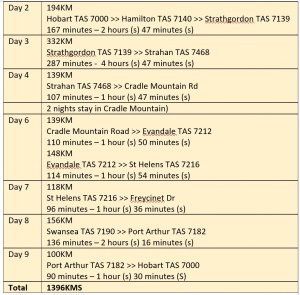
Hello Hobart and Mt. Wellington
Our first activity at Hobart’s was checking out the sunrise at Mount Wellington, one of the city’s most popular attractions just a 20min drive from the CBD. At the peak, you can enjoy a panoramic view of Hobart below and to the east, the Derwent estuary and also glimpses of the World Heritage Area nearly 100 kilometres west. The mountain rises to 1,271 metres above sea level and is frequently covered by snow sometimes even in summer, and the lower slopes are thickly forested but crisscrossed by walking tracks and biking trails. One important tip is to remember that the temperature at the mountaintop is much colder than at sea level. For every 100m you ascent, there is a drop of 1°C. So if you are experiencing cool balmy 17°C in Hobart city, be prepared for a 4-5°C chill at the peak. Likewise, should you plan to capture the sunrise which is generally before 6am, a thick warm jacket is advised. The restroom at the park opens at 8am so make sure to take a toilet break before driving up during the early hours. In the winter season, the road to the peak may be closed for safety concerns, so do check the status update on the city council website.
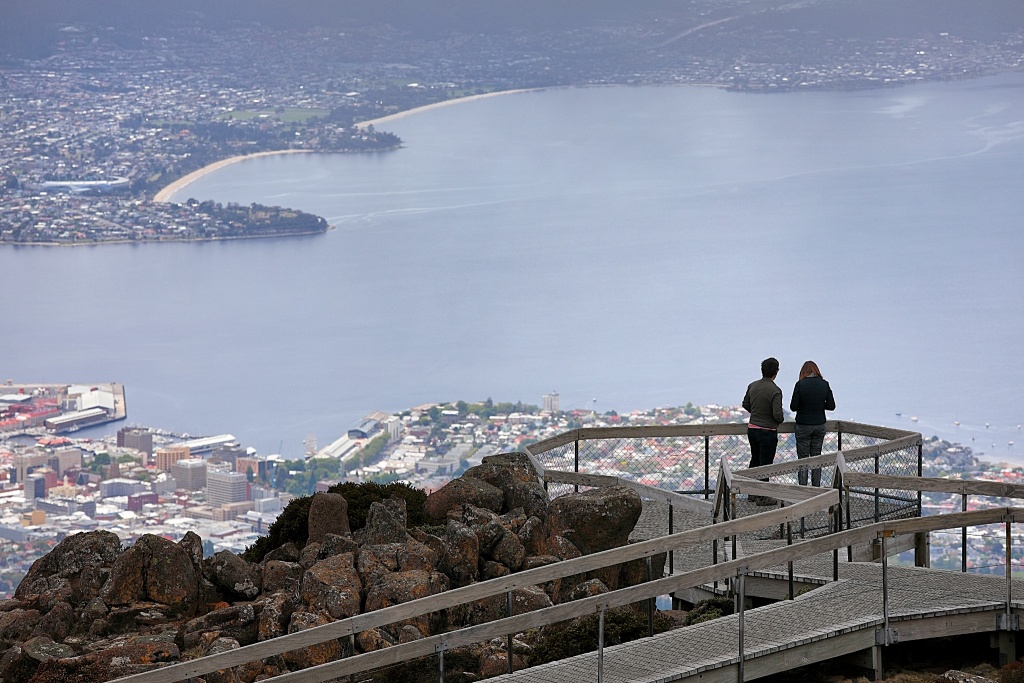
Gorgeous view of Hobart city and Derwent River below. You can also expect frequently the peak to be shrouded in the cloud.
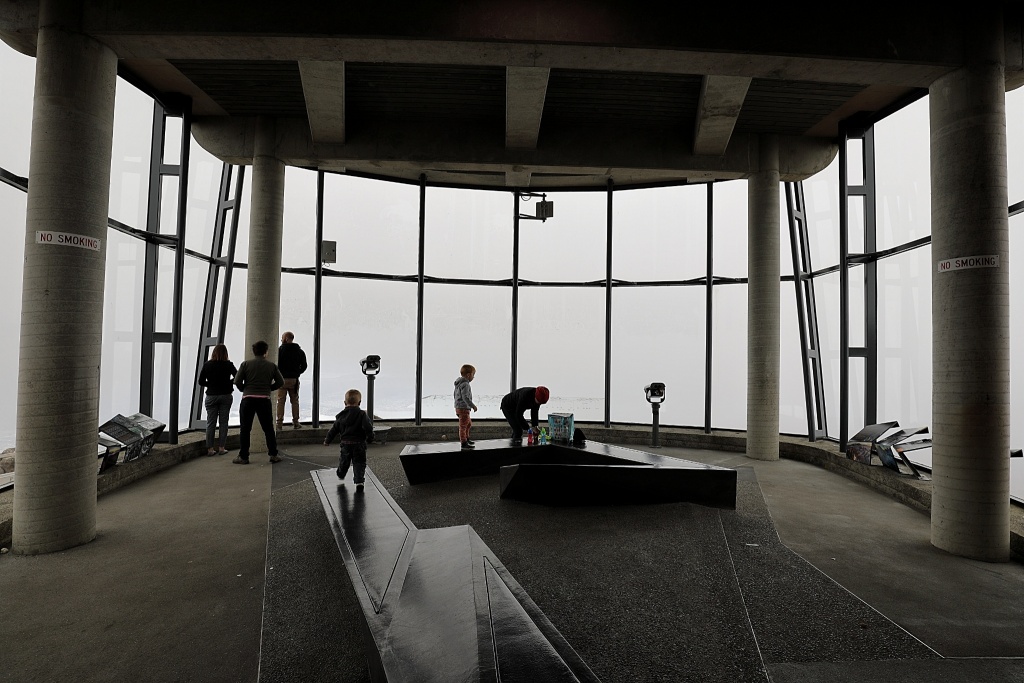
The lookout point at Pinnacle Road. Coin-operated telescopes are available for viewing the distant area.
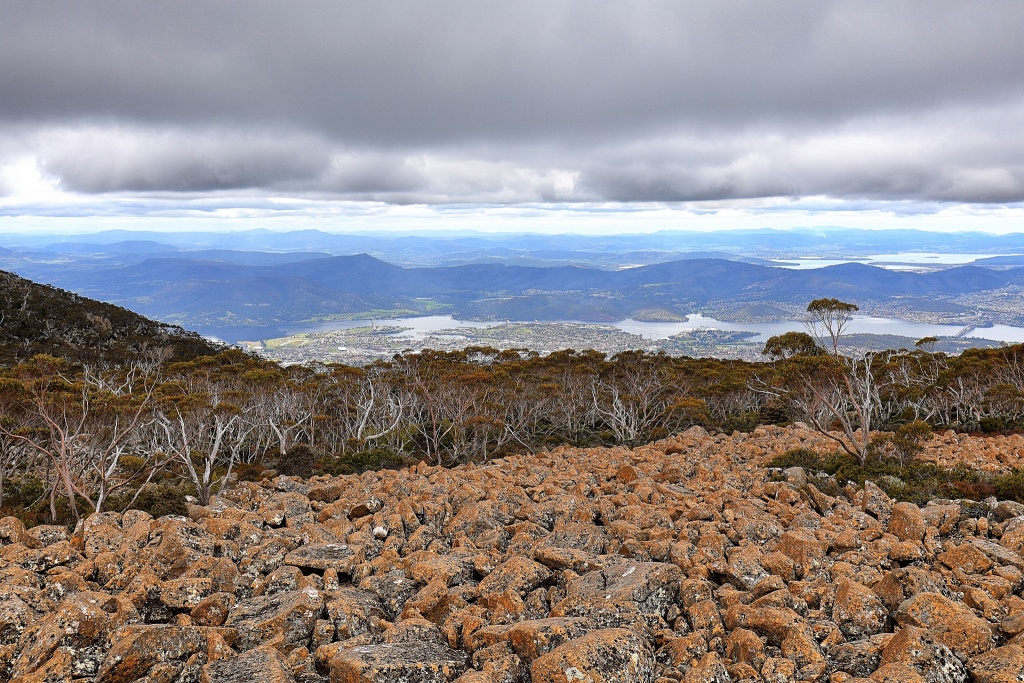
Lovely mountain scenery and you get to feel close to the clouds too.
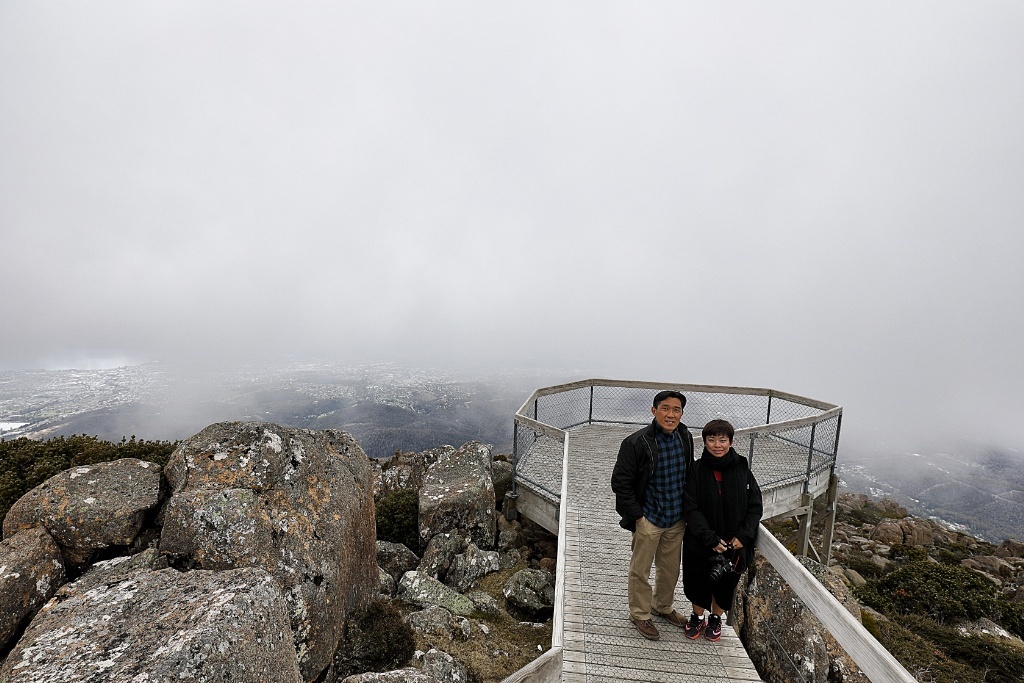
One min the skies were clear, the next minute, clouds came to cloak the sight with her misty veil. Cindy Loo, my travel mate from Jetabout Holidays, which is consistently the top agency in Singapore for Australian vacations for many years now.
In touch with nature @Curringa Farm
Our next task after descending from Mt. Wellington was to stock up on some groceries like cup noodles, drinking water, etc from a Woolworth supermart in Hobart downtown before starting on an hour-long drive to the famed Curringa Farm. Nothing quite prepares me for the amazing moments at this gorgeous 750-acre farm. Incidentally, this farm was featured in the 2013 Mediacorp TV serial – Sudden, starring Rui En and Romeo Tan. My travel mate Cindy, has good working relations with the farm owners Tim and Jane Parsons, so it was like a meeting of old friends. We were hosted to a delicious lunch of Cape Grim beef with garden-harvested greens and lemonade made with Tim’s mother’s secret recipe. Jane even takes time out of her busy schedule to bring us on a farm tour while Tim personally drove us to his colonies of sheep in the middle of the farm, with his sheep dogs for some photo opportunities. This is an award-winning farm with excellent accommodations and superb nature activities that will keep visitors happy during their stay and sad when they leave. I strongly recommend at least a 2-night stay at this beautiful farm.

View of the huge 750 acres farm on a lovely cool summer day. Even my ultra-wide angled lens was unable to take in all the view.
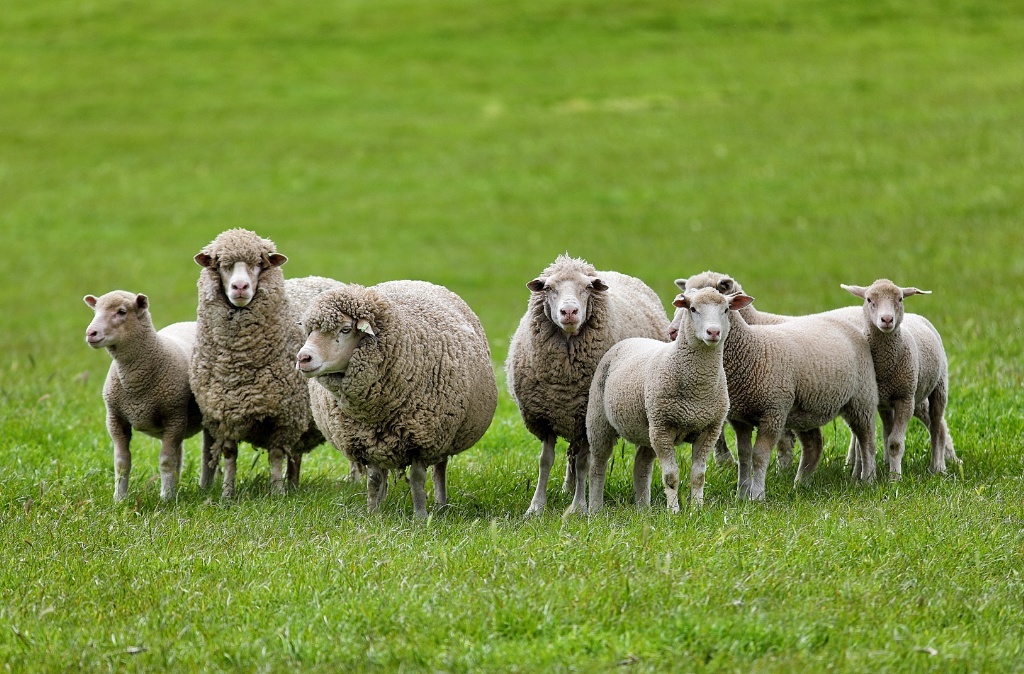
A group of sheep gamely “posed” for me. Farm owner Tim mentioned each sheep have their own personality. That’s more than 2500 personalities on the farm!

A pic of myself and Cindy, among the farm sheep. Picture shot by farm owner Tim Parson.
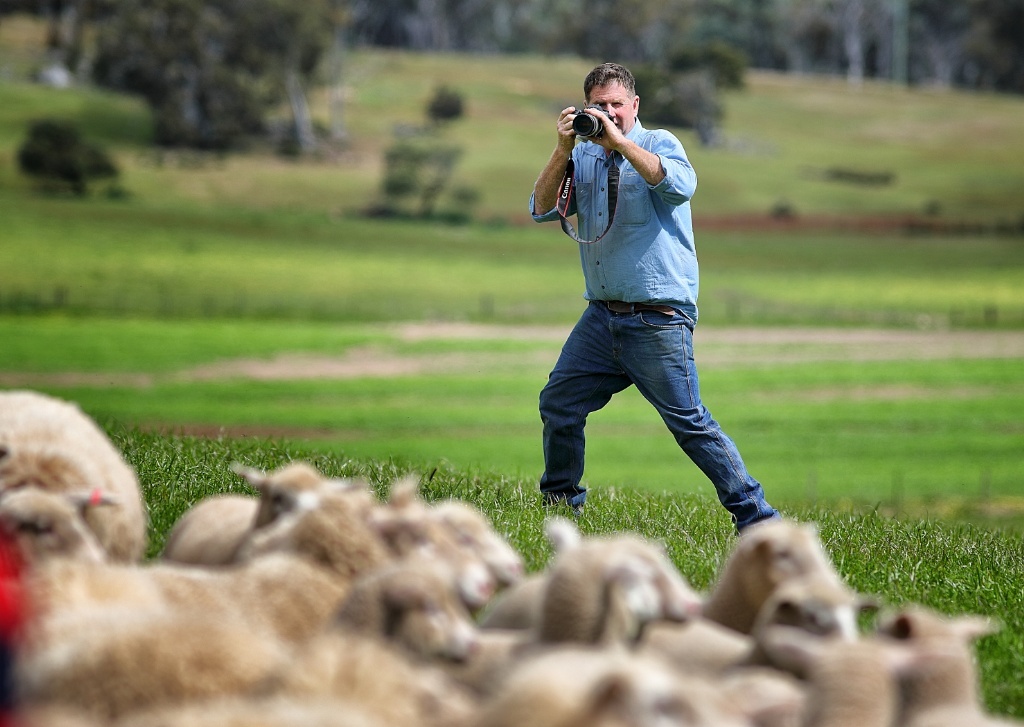
Here’s Tim, the friendly and affable owner of Curringa Farm. He even picked up some Cantonese phrases as many tourists from Hong Kong visit his farm.

The Curringa Farm lists itself as providing 4 stars accommodation. But I like to add it’s a 5 stars experience at this beautiful farm. Two thumbs up!
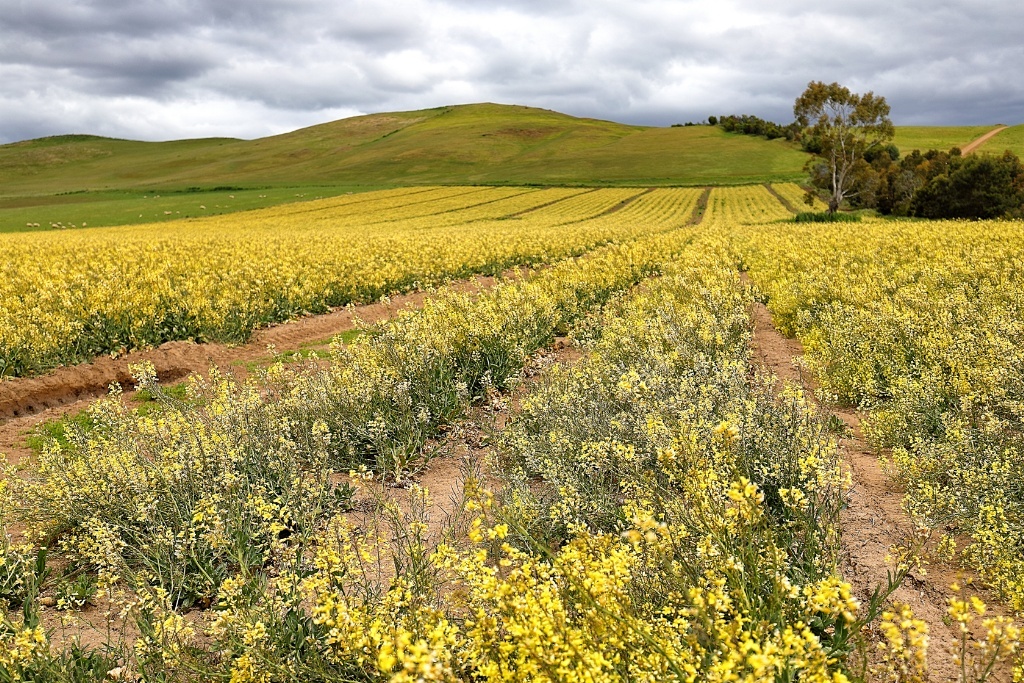
Acres of flowering cauliflowers vegetables. Curringa farm cultivates crops higher up the value chain, growing seeds of vegetables, which are then shipped throughout the world. The cauliflower that you ate could be harvested at this farm.

Utterly delicious hot oven-fresh scones with homemade jam and cream by the farm owner’s wife. Can’t get any fresher than this.
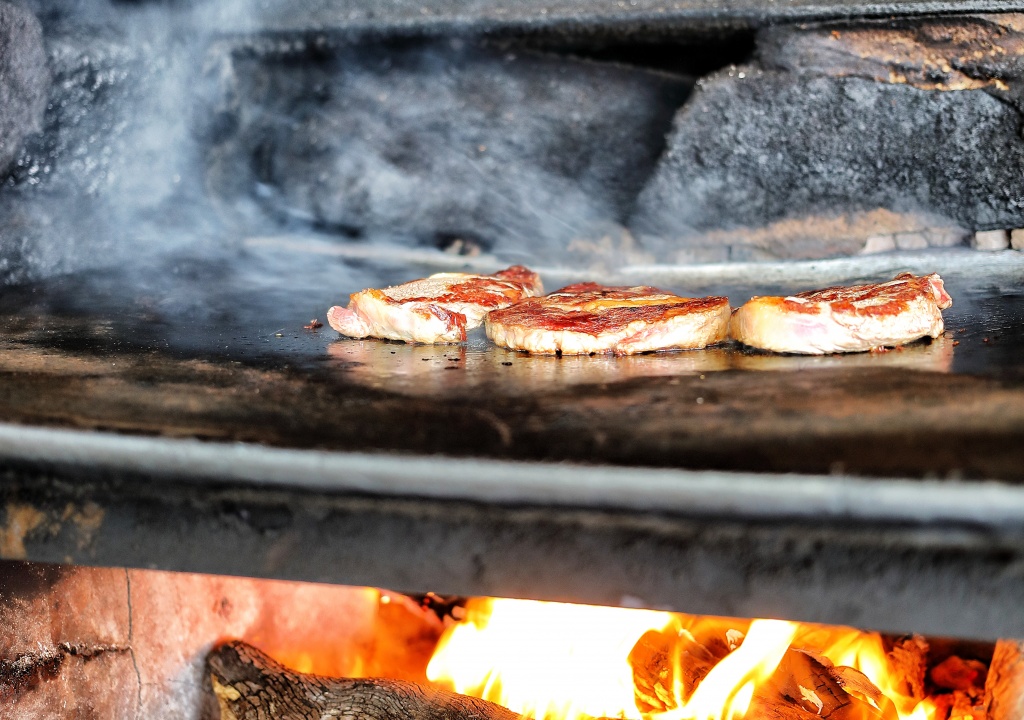
Cape Grim beef sizzling on the hot plate, fired by the wood fire. Cape Grim beef is the finest quality Tasmanian beef you can find on the island. Raised in pristine environment and the cleanest air in the world, it is hand-selected and rigorously graded for guaranteed goodness. Absolutely unforgettable!
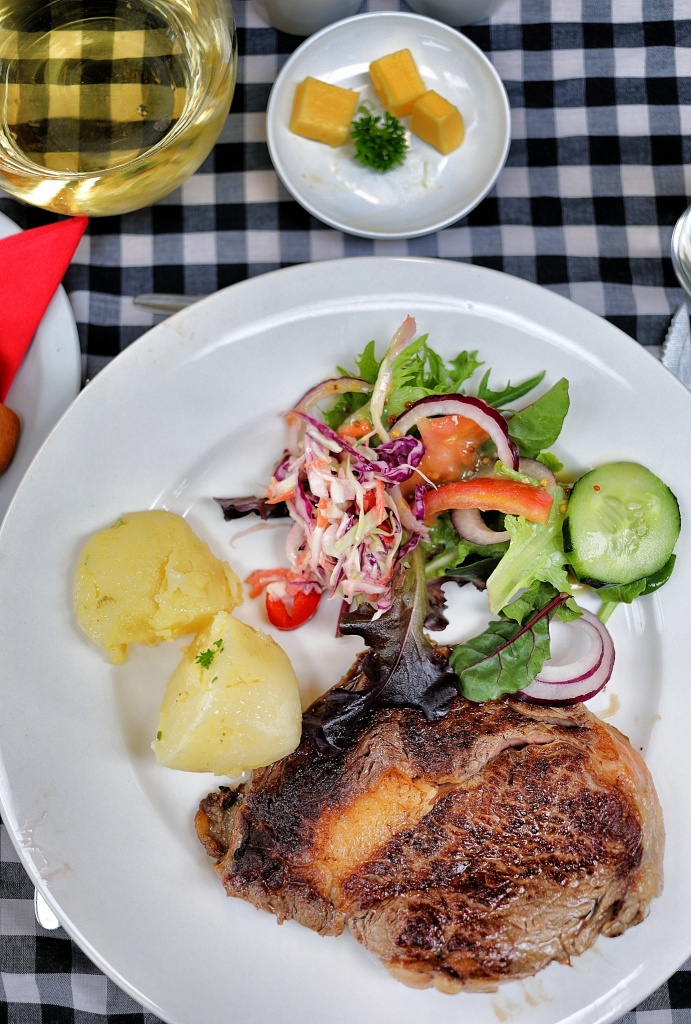
Our superb lunch at Curringa Farm. I am still salivating when I think of this memorable meal.
Southern Lights @Lake Pedder
One of the road trip’s key highlights was the sighting of Southern Lights. For the record, Northern Lights are called Aurora Borealis while Southern Lights are termed Aurora Australis. Researchers described this natural phenomenon “are caused by very fast moving electrons striking atoms in the Earth’s upper atmosphere, primarily oxygen and nitrogen atoms which make up most of our atmosphere. When this happens, it can put these atoms in an excited state. During the process with which they return to their normal state, they emit this excess energy in the form of visible photons.” While it sounds somewhat vague, the real enjoyment of spotting the Southern Lights lies in the pure luck of being able to witness it with our eyes. To increase the probability of spotting this beautiful sight, Cindy planned the accommodation as southerly as possible. It was pure effort that we had to wake up nightly in remote wilderness lodges from about 2am onwards to assess the night skies. We were rewarded with the spectacular sight at Lake Pedder, just one night out of the entire trip. The Southern Lights forecast can be referred online via smartphone app or web forecast. Do be mindful that certain lodges in remote areas are out of data roaming reach and may require additional expenses to buy “satellite internet”. Our accommodation at Lake Pedder is aptly named Lake Pedder Wilderness Lodge. For the best view, the Pedder Wing lakeview room is recommended. One thing to note is that the rooms in this wing are not soundproofed. So be mindful to stay quiet lest it disturbs the guests next door. Its restaurant Twelvetrees serves very good food.
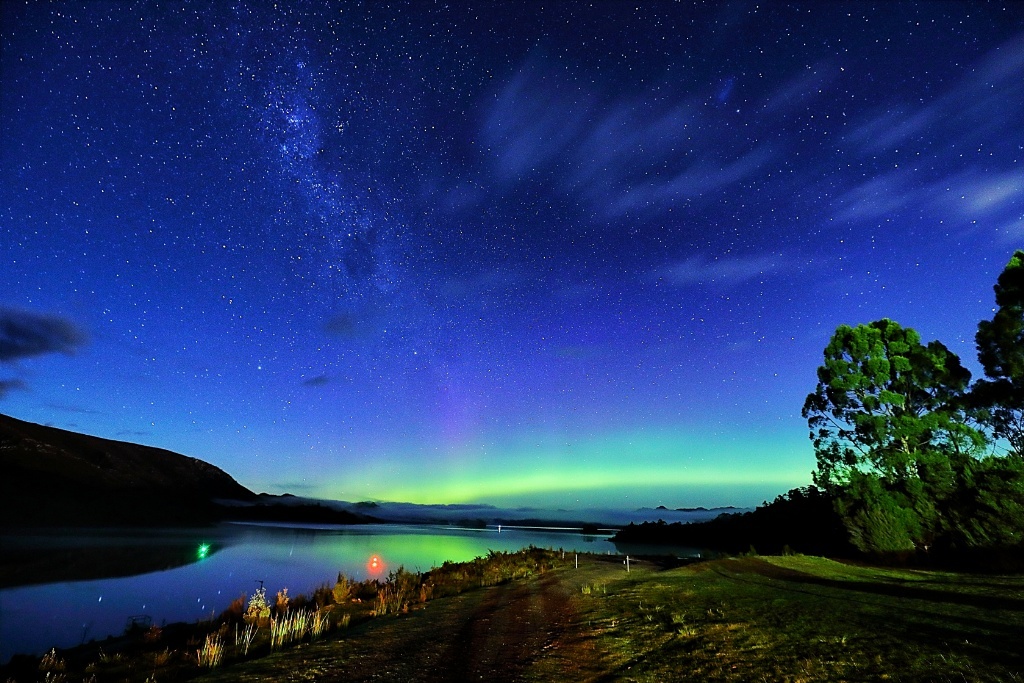
The Southern Lights, one of the trip highlights, finally appeared before our eyes at 2.30am, in 4-5’C chill. We were just so so lucky.
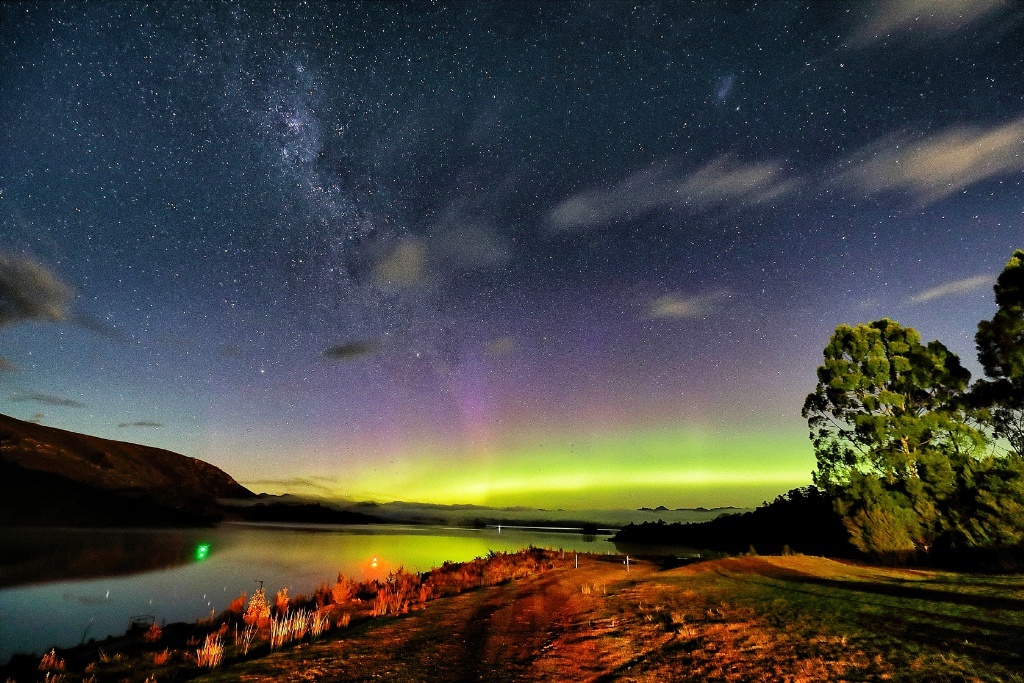
As time progresses, the Southern Lights (Aurora) became more intense. It looked more vibrant on the camera LCD screen after 30s exposure. With our naked eyes, it somewhat looked like an “early morning sunrise” at 230am. In fact, we were not quite sure if that was the Southern Lights till we see it on the LCD screen and of course, that’s the Milky Way at the left side.

The clouds coming in, time with the Aurora ending soon, after enjoying it for almost an hour.
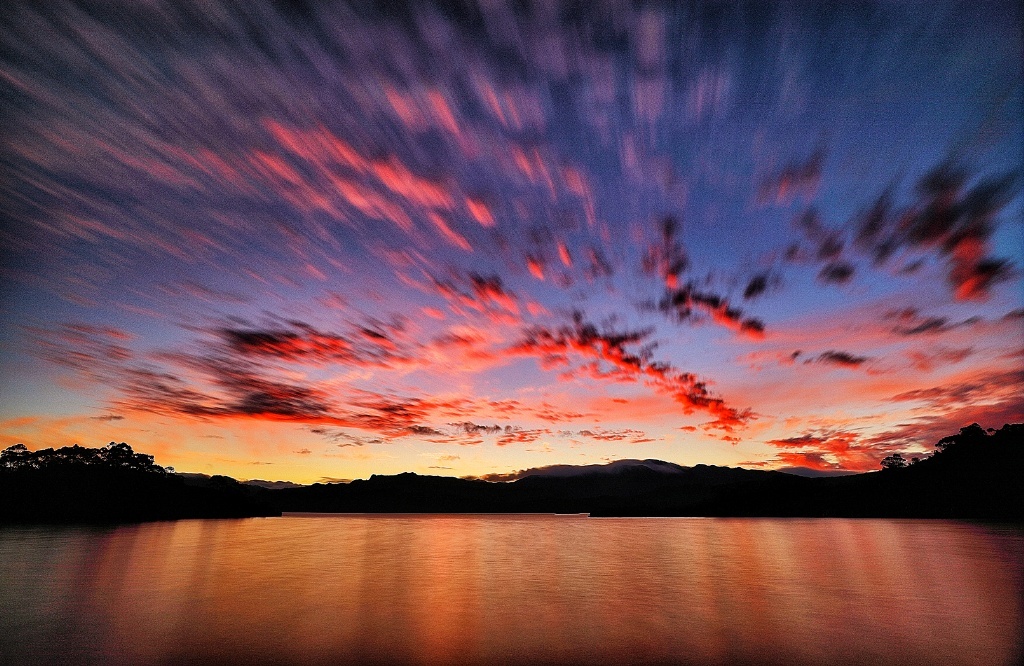
According to the lodge staff, Lake Pedder is usually cloudy, so we were blessed to be able to capture the Southern Lights, and also an awesome sunset on the day we arrived, as you can see in this picture shot at Ted’s Beach, just 5min drive from the Lake Pedder Wilderness Resort. To enjoy nature better, we do not expect but just take what is given.
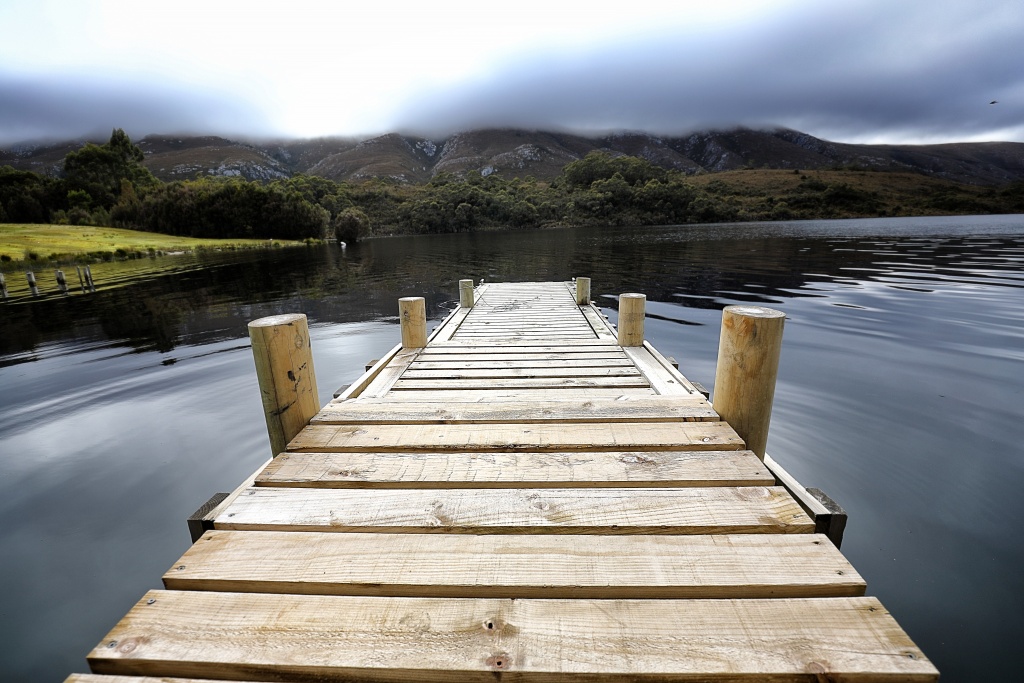
The Lake Pedder Wilderness Resort surrounding is a picture of tranquillity. For city folk like me, the totally serene ambience, broken only by the occasional birds chirping or rustling of leaves by the wind are truly a rare treat.

Submerged plants in the lake were captured in a monochromatic setting. Like a painting, naturally.

The floral and fauna by the lake are something we can’t see in Singapore’s tropical climate.
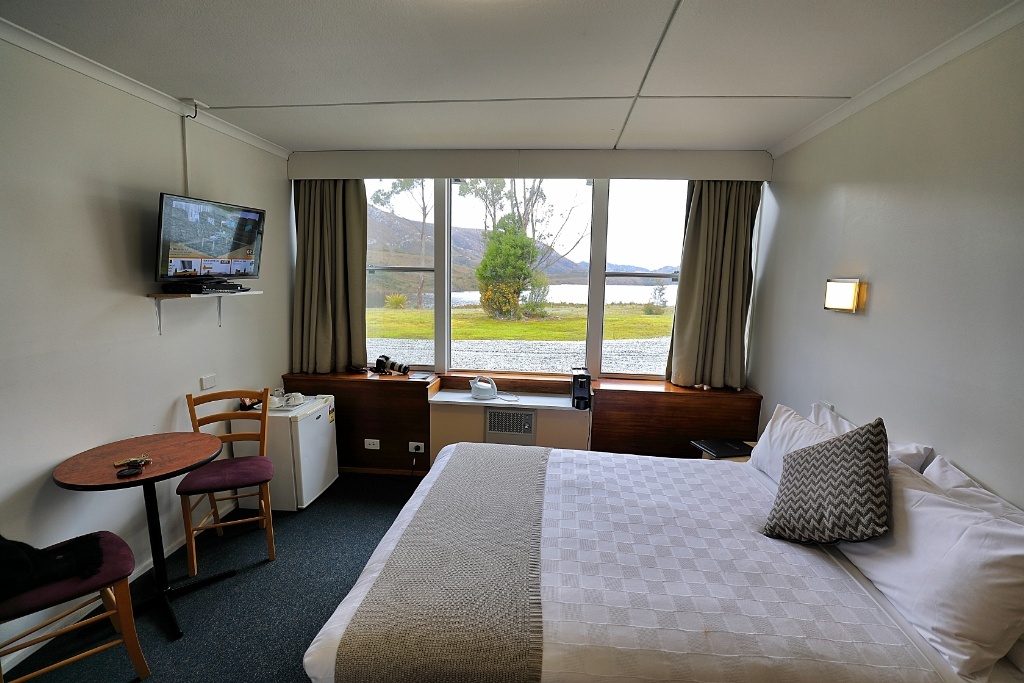
The Lake Pedder Lakeview room. Comfy, clean and basic but best positioned to enjoy the beautiful scenery. Just keep your volume down as the walls are not soundproofed.
Amazing human engineering @Gordon Dam
A short 11min drive from the Lake Pedder Wilderness Lodge brought us to the spectacular Gordon Dam. This dam, also known as the Gordon River Dam, was built in 1974. At 198 metres (650 ft) long and 140 metres (460 ft) high, it is the tallest dam in Tasmania and the fifth-tallest in Australia. Power from this dam caters up to 13% of Tasmania. Approximately 48 arch dams have been built in Australia and only nine have double curvature. It may not have the immense scale of the famed Hoover Dam in the USA but this dam is a pretty awesome sight and a testimony to Australian engineering prowess.
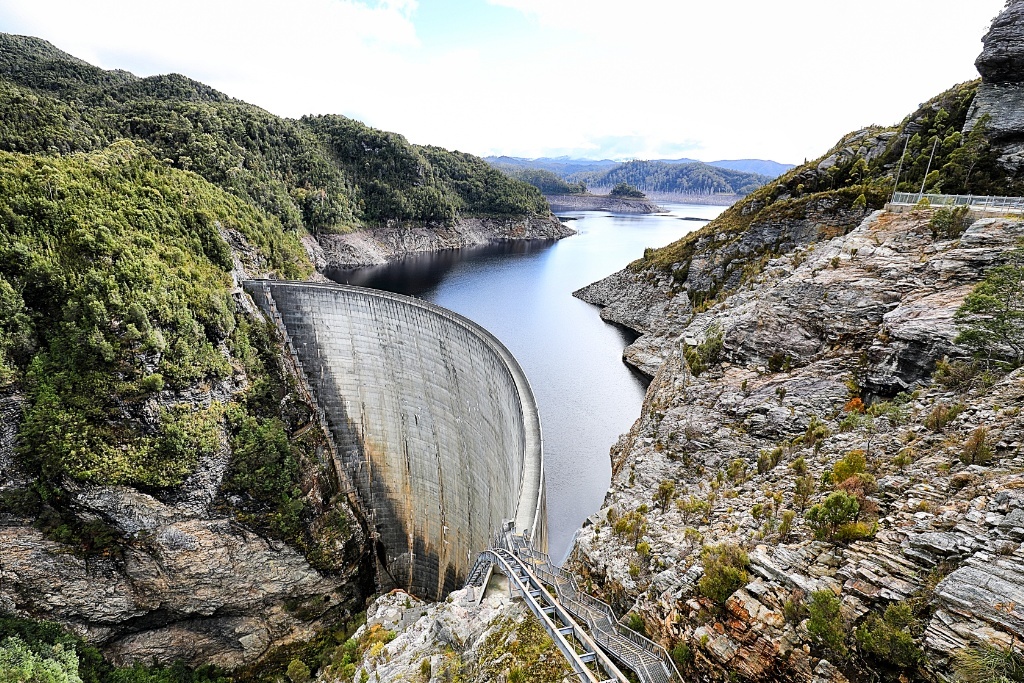
The Gordon Dam. Great to shoot during daytime and even more scenic during dusk.
Gorgeous Russell Falls @Mt. Field National Park
From Gordon Dam, we drove about a hundred kilometres (1.5hr) to the Mount Field National Park which was founded in 1916. Together with Freycinet National Park, it’s Tasmania’s oldest national park. The area around Russell Falls has been preserved for its natural beauty since 1885 when it was set aside as Tasmania’s first nature reserve. The Russell Falls is one of the scenic waterfalls in Tasmania and is easily reached after a 20 min stroll on a level walk path (suitable also for wheel-chaired visitors too). The walking track to the falls is framed by stunning tall tree ferns and at night time, glow worms can be seen among the vegetation. It is at this national park entrance that we have to pay an AUD60 car parking pass that entitles us to park at the rest of the national parks through the remaining part of the road trip. So, do not lose that vehicle pass ever.

This 295m waterfall has 2 tiers, with lush tropical foliage fringing the falls. When you are shooting the pic, be careful of the misting from the cascading waterfall which may damage your camera. Just observe the wind direction.
Beautiful landscapes along Lyell Highway
Along the long stretch of highway that seemed to go on forever, sometimes driving for almost an hour without seeing another car, do schedule short rest stops along scenic spots whenever possible to enjoy the expansive views. You can see landscapes with unique floral and fauna that seemed too beautiful that defied explanation. You tend to wonder if it’s all human-cultivated or naturally occurring. Such is the awe that the Tasmanian natural beauty inspires in you.

A solitary Eucalyptus tree makes for great photographic framing with acres of button grass around it. A wonderful place for Instagram pictures indeed.
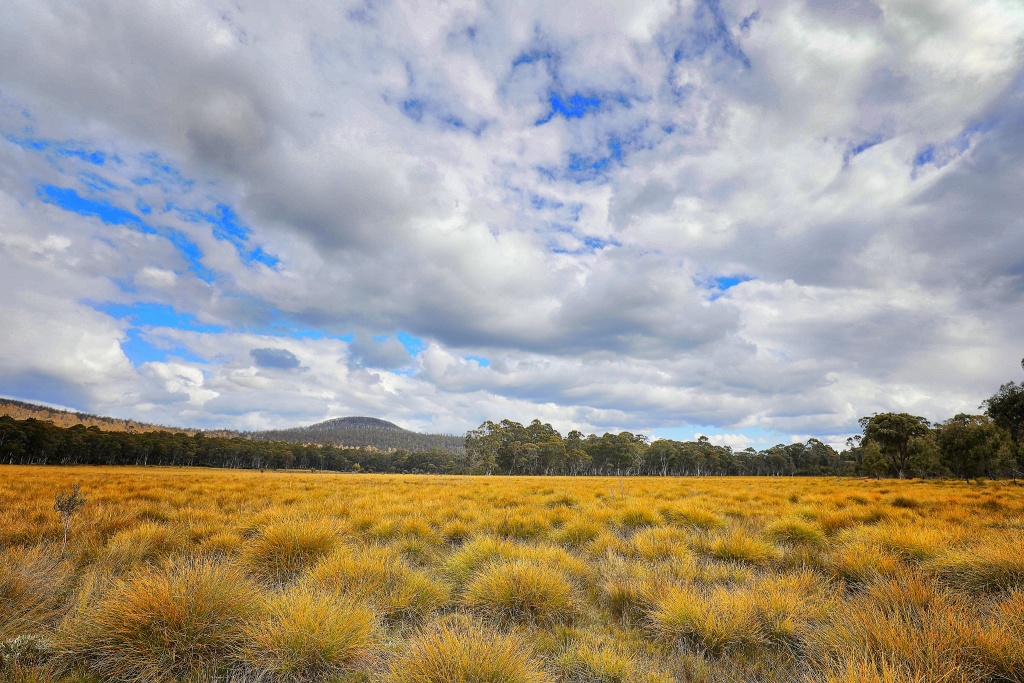
Button grass forms part of a unique habitat in Tasmania and despite the wet climate, button grass is relatively flammable. Should you want to walk among to shoot pictures, do be careful as it’s rather spiky and will irritate uncovered legs.

Wide vistas of serene and calm skies and well-paved roads are a driver’s best friend on a road trip. Our rental Chevrolet Cruze estate held up well, hugging the windy roads like a leech while cocooning us in cool comfort.
Epic carvings @The Wall
When my travel mate Cindy mentioned our next destination after a long 2-hour drive (131km) is a place where we can view wood carvings en route to the town of Strahan , I was honestly a little underwhelmed then. However, upon reaching this amazing place in the heart of Tasmania, I was anything but immensely impressed! I paid the price for ignorance by feeling “underwhelmed”. This is a place with epic history in the making. The self-taught sculptor is Greg Duncan and his philosophy for his colossal project is clear and simple – ” The idea for The Wall is quite a simple one,” Greg says. “I’m carving a series of 100 panels. Each panel is one metre wide by three metres high. The panels will be placed back-to-back. So, by the time I finish, I’ll have created a wall 50 metres long with carvings on both sides – 100 metres all up.” The idea sounded simple but in reality, the scale is mind blogging! His objective is to carve 300 square metres of wood to form The Wall, a task he estimates will take ten years to complete. So a visit to The Wall is actually seeing history being made. The venue has admission charges and photography or videography is not allowed. Pictures used in this segment are reproduced with courtesy of Greg Duncan.

The master sculptor, Greg Duncan. Man on a mission.

Epic work in progress. The carvings are an embodiment of skill, vision, mission, patience and determination all rolled into one. Truly spectacular.
Fairy Penguins spotting @Bonnet Island
After another 2 hours (129km) from The Wall, we reached the idyllic harbourside village of Strahan (pronounced Straw-n) in the late afternoon. This phase of the road journey is marked by windy roads that took me about 45min to tame. Do observe the driving speed and local road conditions. Originally developed as an access hub for the mining settlements in the area, Strahan was known as Long Bay or Regatta Point until 1877, when it was formally named after the colony’s Governor, Sir George Cumine Strahan. From my research, the quaint town only has a small population of 660 based on a 2011 census. Our visit to Strahan is essentially to spot fairy penguins at Bonnet Island, one of the top 10 things to do here. The event was a 2.5-3 hours twilight cruise conducted by Gordon River Cruises to the remote and isolated small island where lighthouse keepers and their families worked. This is one of the best places to spot penguins in Western Tasmania as the island is now the habitat to a colony of small-sized Fairy Penguins. Watching these cute creatures (the boat guy even assigned names to each of them) returning from foraging for food in the sea was indeed a privilege. We also enjoyed lovely coastal scenery and sunset en route to the island.
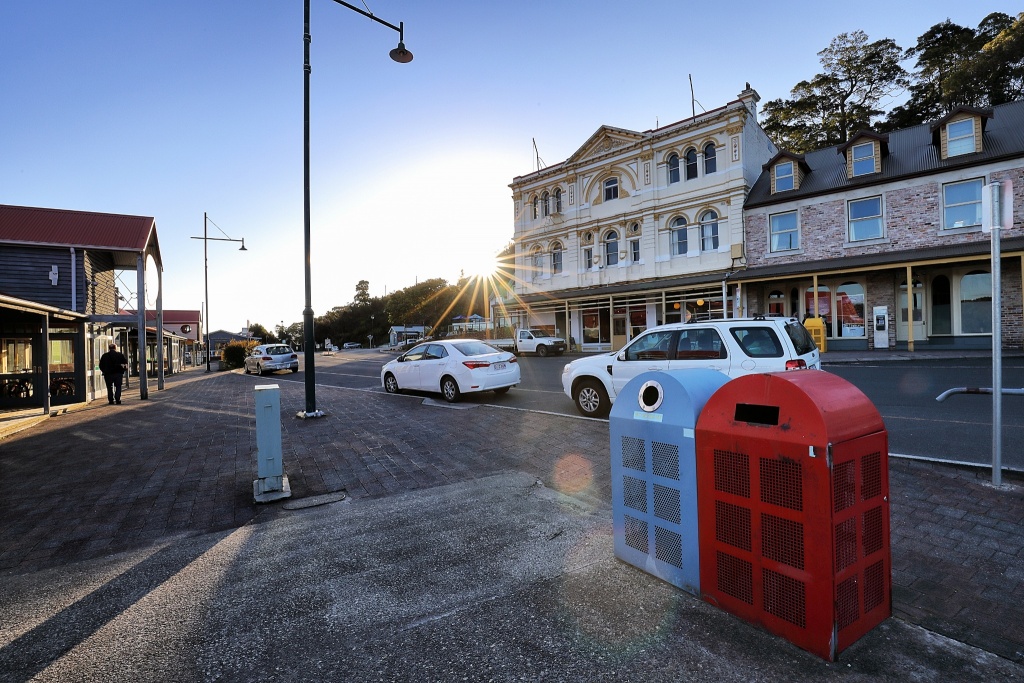
The lovely quaint town centre of Strahan at sunset. The red and blue boxes are recycling stations.

Our transport for the evening, the MV Sophia. manned by professional staff who regaled us with a history of the location and kept the event interesting.

One of the fairy penguins we spotted that night. No flash is allowed so as to protect the penguin’s eyes. Instead, torches with red filters are used to light up the place for photography.
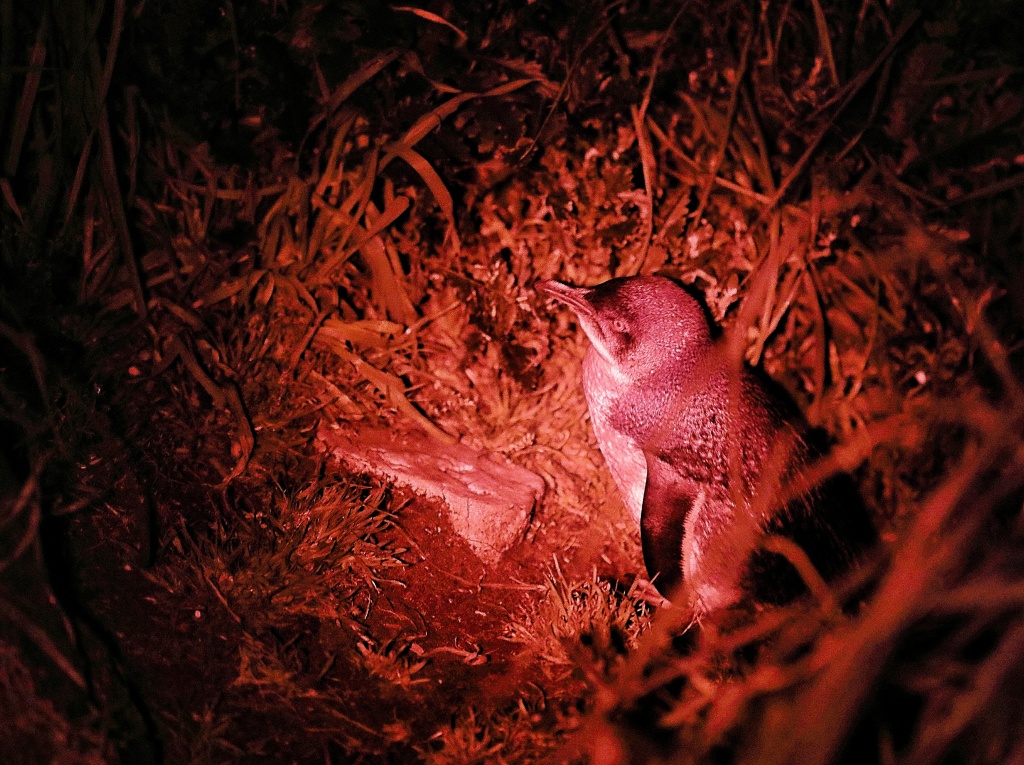
Think this one is called George. As the place is the home of the penguins, expect to experience the smell of sort like chicken poo”. When it’s windy, it’s more tolerable.
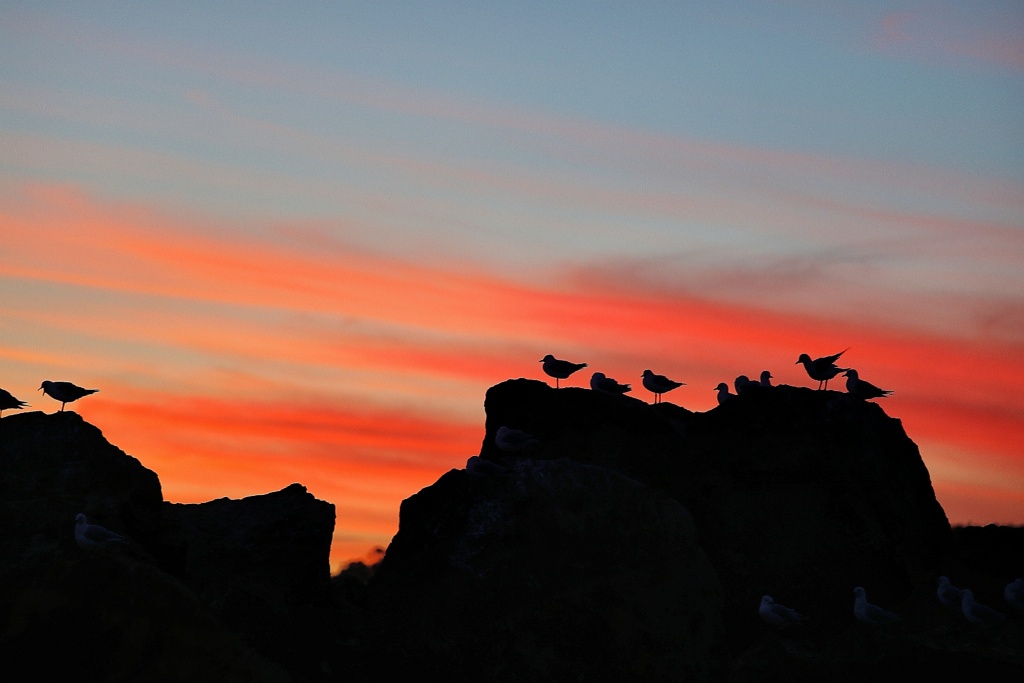
A nice coastal scene we saw along the way to Bonnet Island.
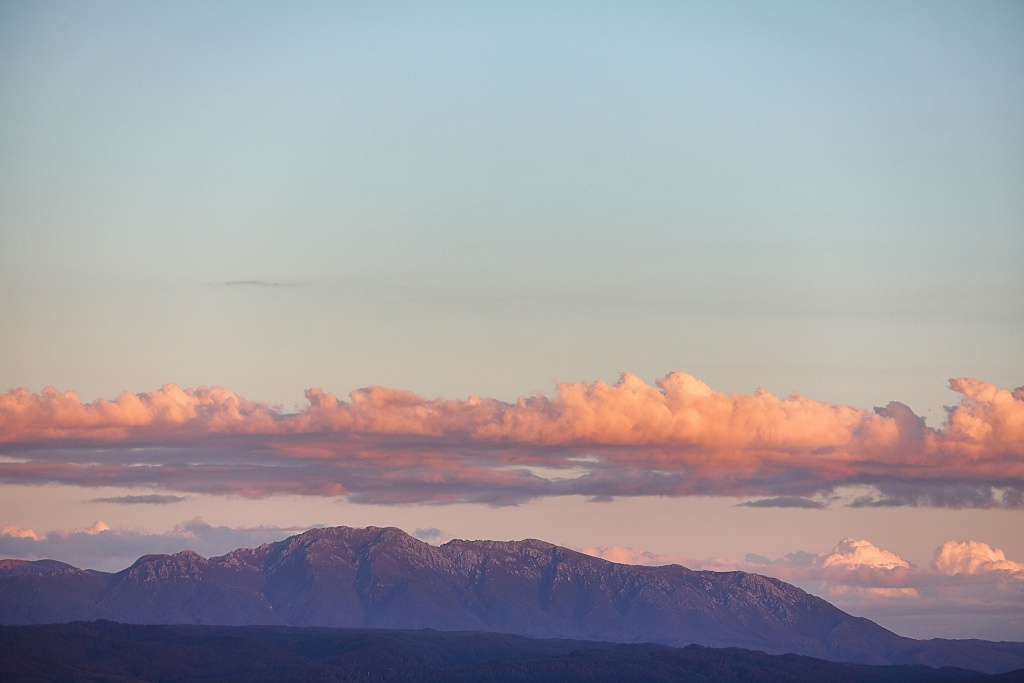
Beautiful coastal dusk colours at Strahan. Does look like a scene out of Mexico wilderness.
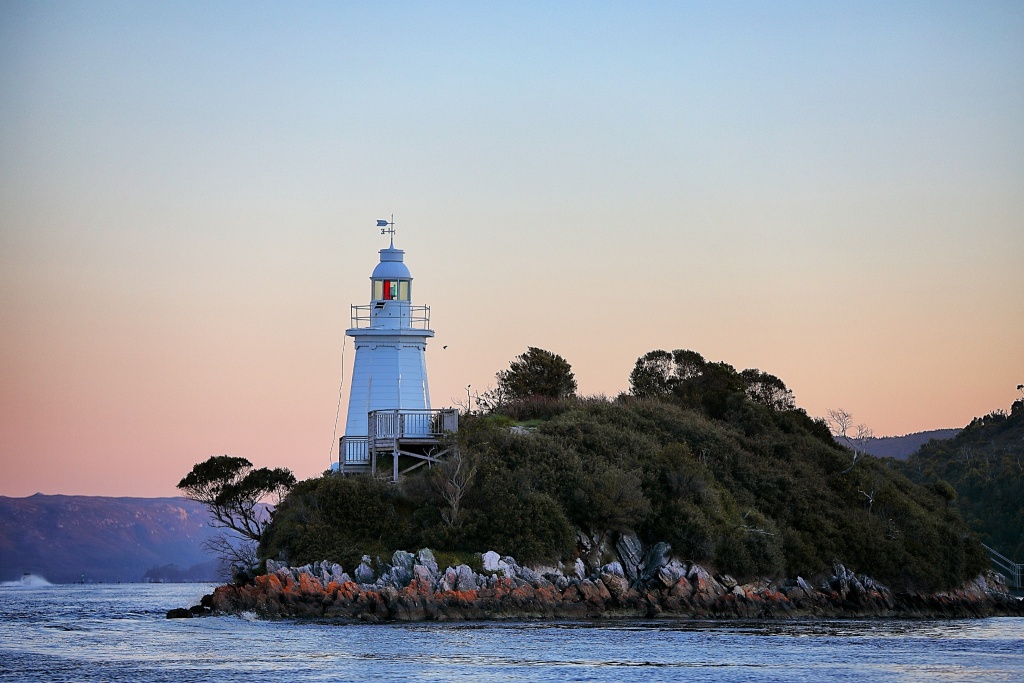
Idyllic lighthouse by the bay. Certainly a romantic scene.
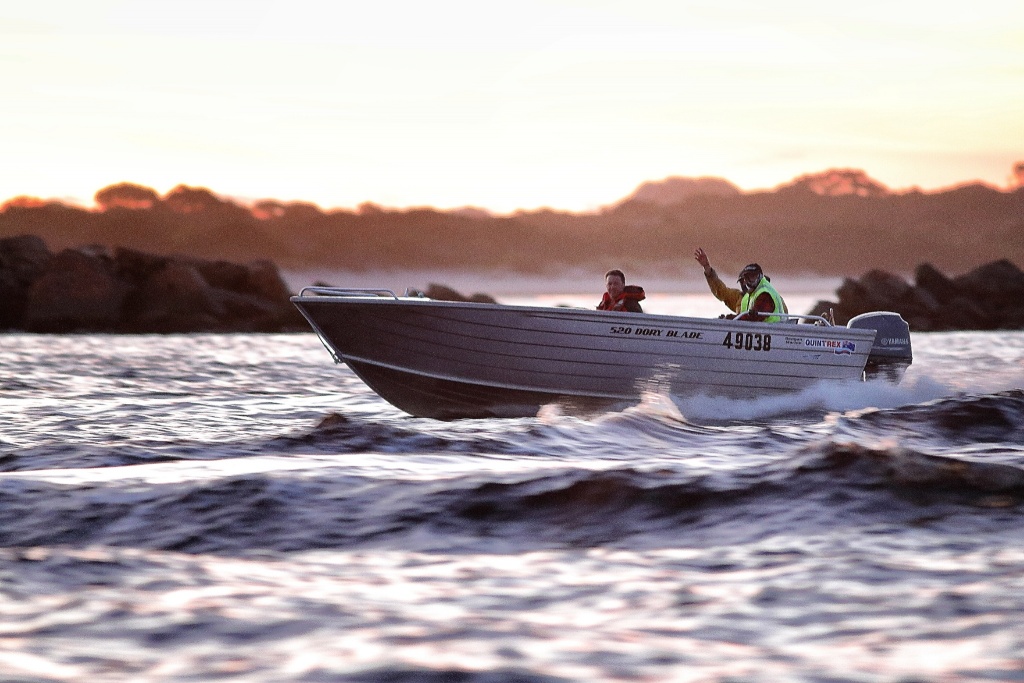
The locals are really friendly, both on land and at sea.

Accommodation at Strahan. The Ormiston House at 1 Esplanade. A beautiful grand federation mansion situated on the shores of Macquarie Harbour. Ormiston House was built by Frederick Ormiston Henry the founding father of Strahan and has been lovingly restored in the mid-1990s. It’s the first time I slept on 4 poster bed and the warm personalized service is amazing.
Enchantment @Cradle Mountain
From Strahan, I drove almost 139km over 2 hours before reaching Cradle Mountain situated in the Cradle Mountain-Lake St Clair National Park. My interest in this fabled location was triggered when a few of my friends told me how beautiful this park was as they visited it during their honeymoon decades ago. And indeed, it was a spectacularly scenic location with ever-changing “mood” and “feel” at various times of the day. It was indeed appropriate that Cindy scheduled 2-night stay at this location as it was so vast and multi-faceted that just an overnight stay here would be a “crime”. But even so, being such a huge park at 1,614.43 km² (Singapore is 719.1 km² for comparison), I strongly felt even a week’s stay here is still not enough. And just as nature rewarded us with pleasant weather so far on the trip, the skies opened that mid-afternoon, cutting away what little precious time we had at the park. With the inclement weather, it also meant that any sighting of the Southern Lights here would be a foregone conclusion. It was with some blessings that we had a window period of fair weather the following day, permitting us to take in some nice angles of the lake and visit the Tasmanian Devils Conservatory at the Devils@Cradle. Our accommodation of choice here was the Cradle Mountain Wilderness Village which was luxurious and a very well-thought-out resort.
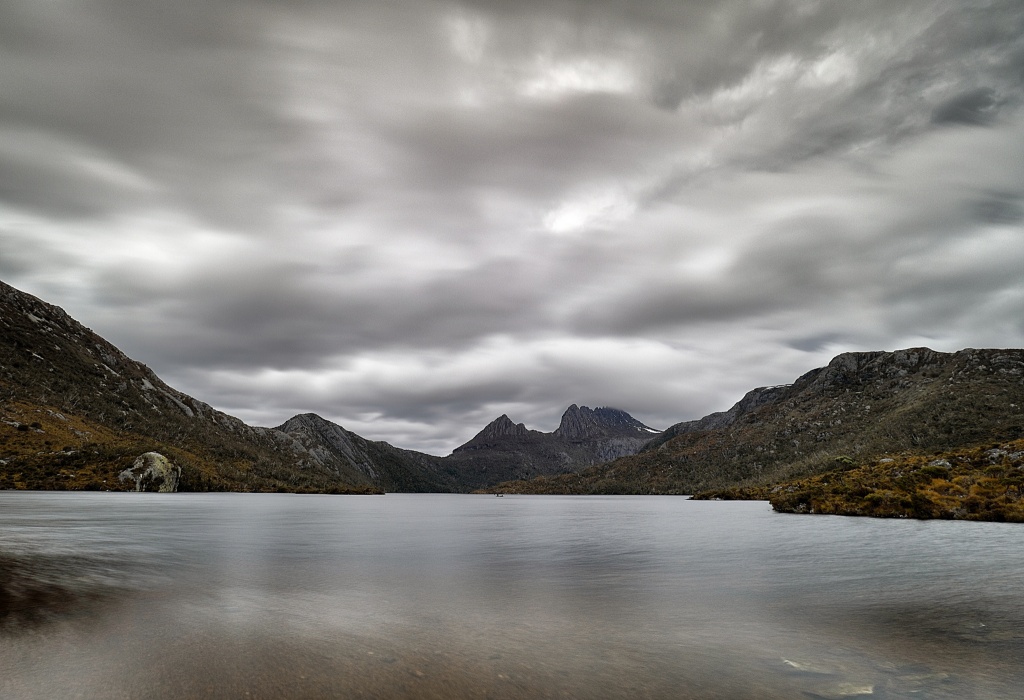
On the afternoon of our arrival, the skies at Cradle Mountain were looking ominous. We managed to grab a few angles and walk a short stretch of one of the trails before the rain decided for us to return to our lodge.

Along the trail, special “assigned” framing posts are set up to assist visitors with that “ideal perfect” angle. Just rest your camera or handphone on the pole and press that shutter release.
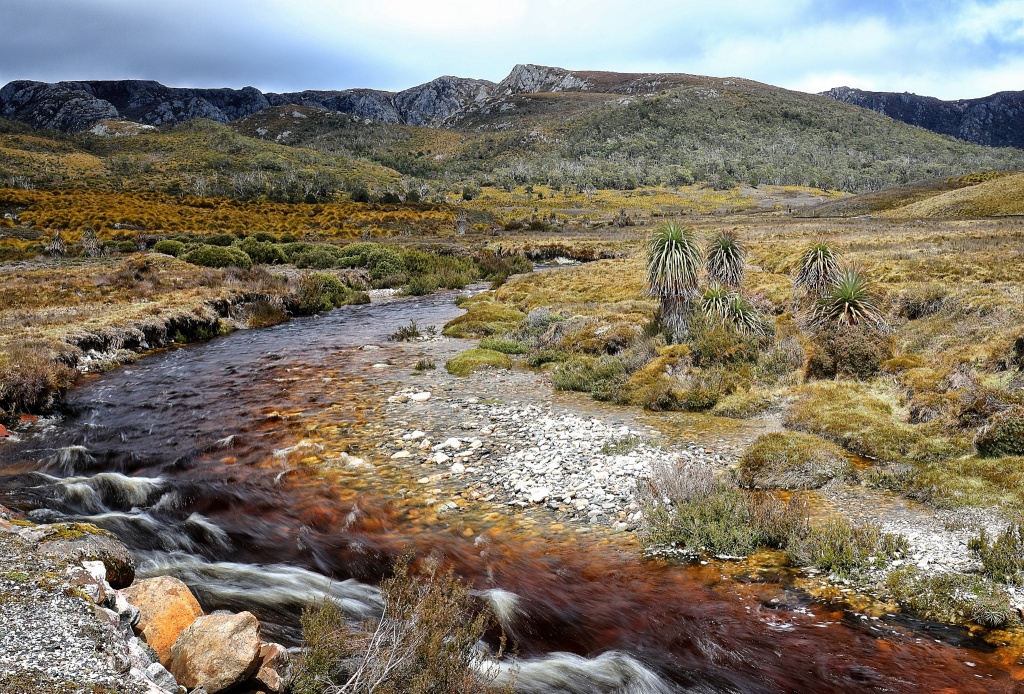
The flowers and fauna at the park are beautiful and will keep nature lovers fully entertained and intrigued. The streams at the park are stained a dark amber brown by the tannin from dead leaves. This tannin-laced water finds its way to the resorts and lodges around the park when you set up the bathtub for soaking. No worries, it is perfectly safe.
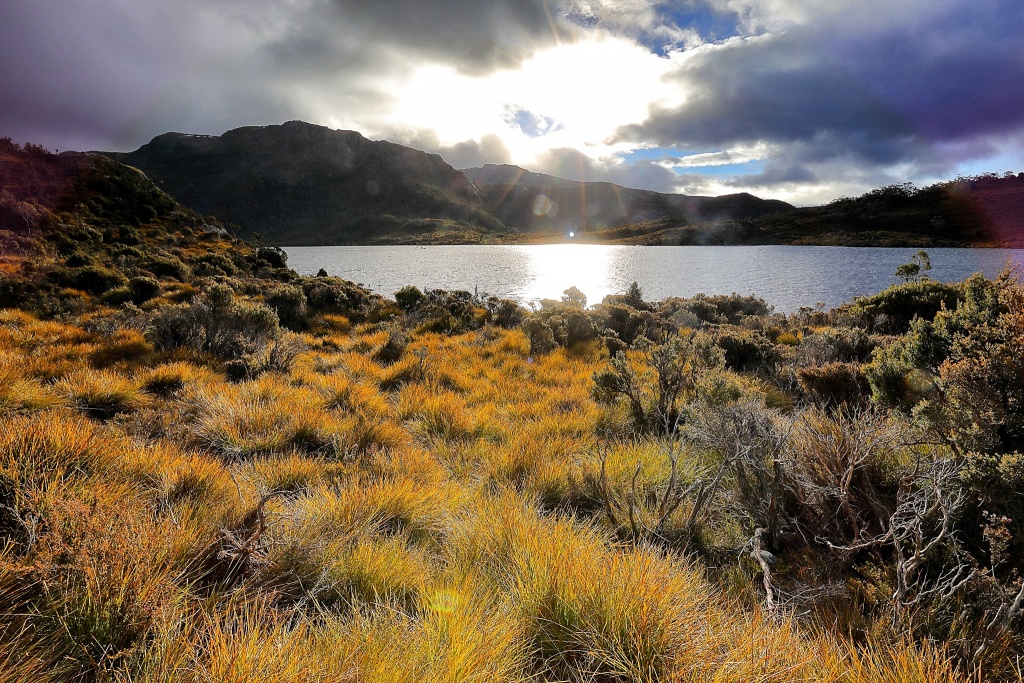
On the following day, the sun peeped out just for a short spell, for me to take in this back-lighted landscape.

A wallaby with her joey (baby) in her pouch along the trail. A lovely sight that endears visitors to the park.

You will spot lots of Tasmanian native hens – a stocky flightless bird between 43 and 51cm in length. The upper parts are olive-brown with a white patch on the flank. The underparts are darker with a bluish-grey tinge. The short tail is close to black and mostly held erect. The legs are thick and powerful, with a grey-scaly appearance and sharp claws. The eyes are bright red. The bill has a small frontal shield and is a greenish-yellow colour. The juvenile bird is similar in appearance to the adult, but the colours are more subdued on the body and the underparts have fine white spots. And these hens are good swimmers.
Get up close with the Tasmanian Devils@Cradle
This is a unique Tasmanian conservation facility focusing on Tasmania’s three carnivorous marsupials, in particular, Tasmanian Devil and the Eastern and Spotted-tail Quoll. We were treated to a video documentary and a detailed talk by a passionate park keeper who then leads us out to a guided walk to the Tasmanian Devils’ enclosure. Much is touched upon the Tasmanian devils, which are the largest living marsupial carnivore the approximate size of a solid squat dog.
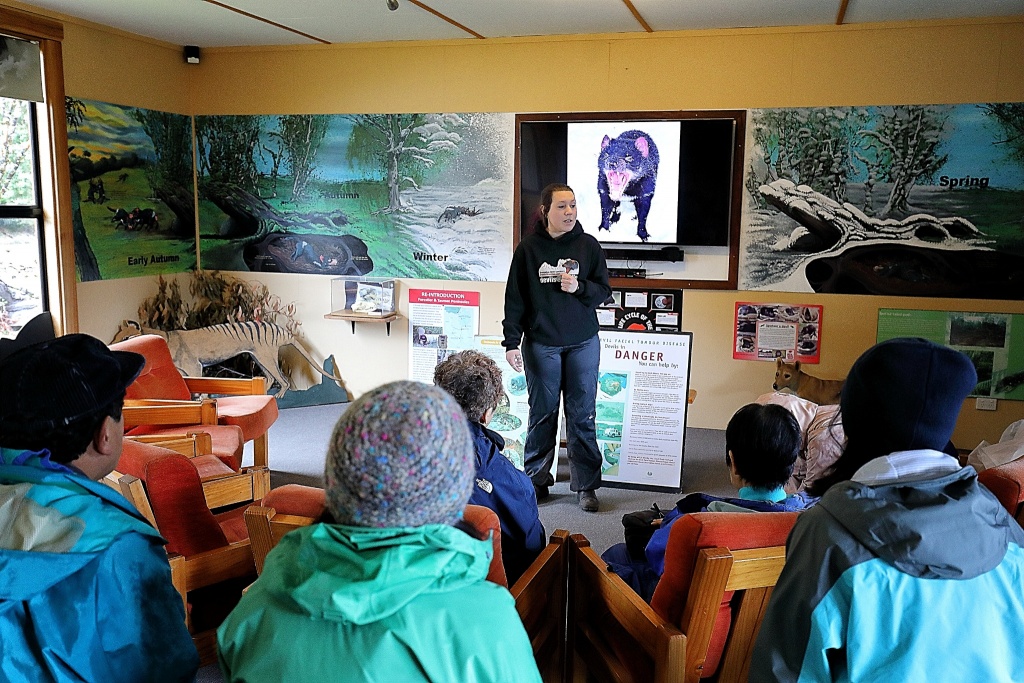
At the rehabilitation centre, the keeper gave a talk on the Tasmanian conservation work of the centre and some interesting info on the fiery marsupial that is synonymous with Tasmania.
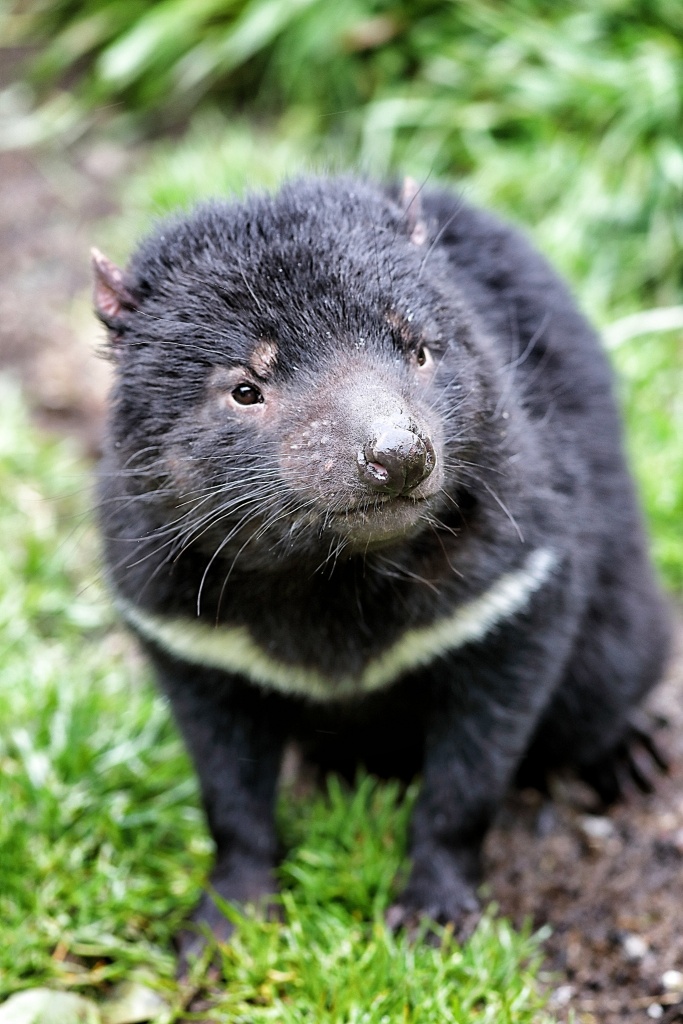
Looks can be deceiving, the Tasmanian devil’s large head and neck allow it to generate among the strongest bites per unit body mass of any existing mammal land predator.
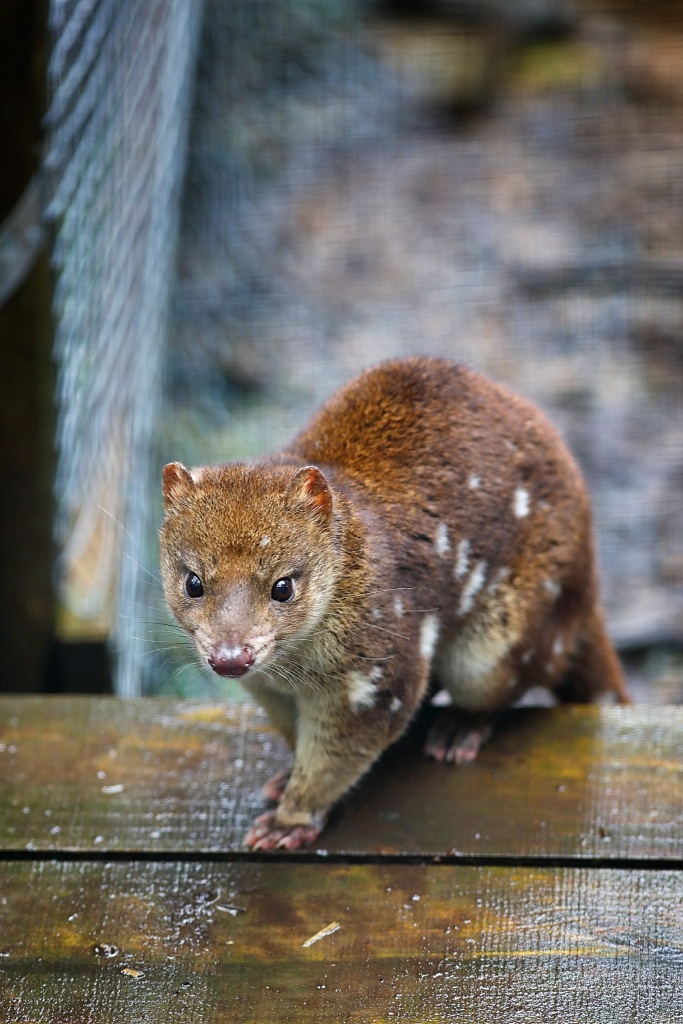
The spotted quoll, is also known as the Tiger quoll, With males and females weighing around 3.5 and 1.8 kg, respectively, it is mainland Australia’s largest carnivorous marsupial, and the world’s longest-living carnivorous marsupial (the biggest is the Tasmanian devil)

A wallaby is a small- or mid-sized macropod found in Australia and New Guinea. Most tend to confuse kangaroo with wallaby. It is a marsupial or pouched animal that is a member of the kangaroo family. There are around 30 different species of Wallabies, which are smaller than kangaroos and distributed widely across Australia and neighbouring islands like New Guinea.
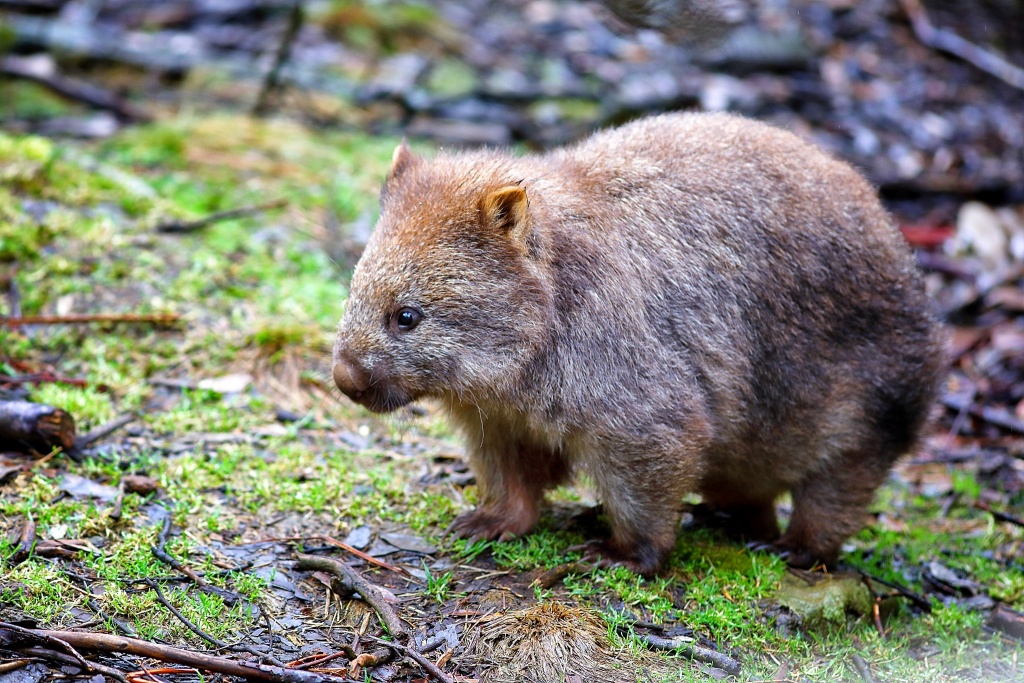
Wombats are short-legged, muscular quadrupedal marsupials that are native to Australia. They have an extraordinarily slow metabolism, taking around eight to 14 days to complete digestion, which aids their survival in arid conditions.
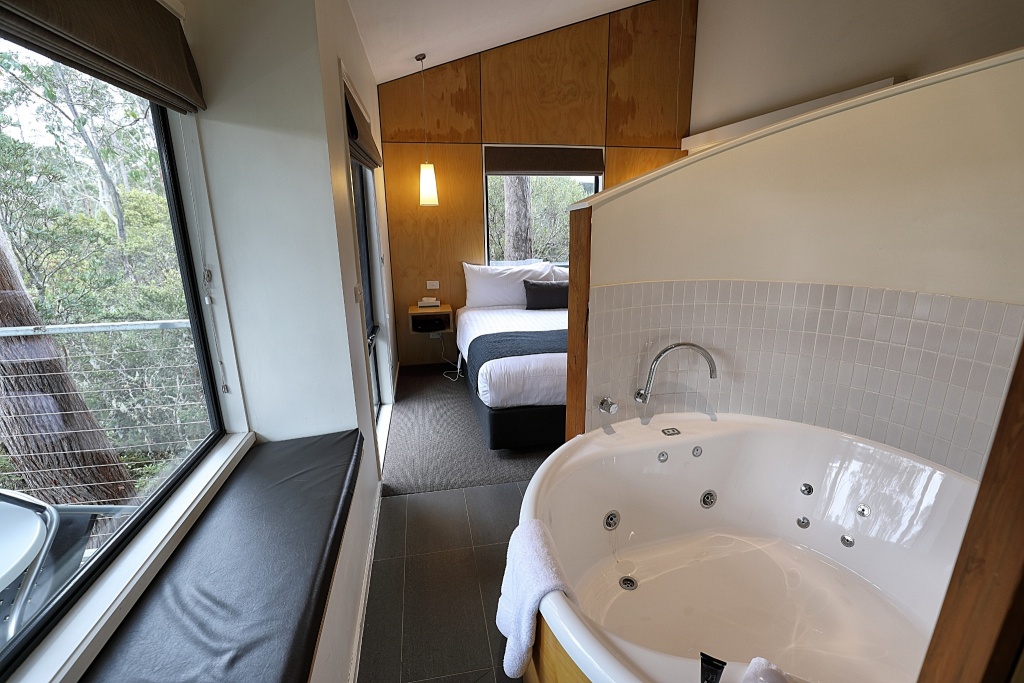
Our choice of accommodation here is the Cradle Mountain Wilderness Village. The self-contained cottages and chalets are carefully sited in the rainforest so guests are surrounded by native plants and wildlife. The room overhead window even looks into the forest so you get waken naturally by new day sunlight if you chose to draw the curtain.
Wall Murals @Sheffield
After leaving The Cradle Mountain, our next destination was St. Helens, which was 288km away on almost a four hours drive. We made an unscheduled pit stop and chanced upon the interesting town of Sheffield. What piqued our interest in this quaint town was the immense wall murals. Sheffield was one of the many early townships that settled in 1859. With the completion of power projects in the nearby area in 1973, the town population began to dwindle after the heydays of project construction. Sheffield’s revival as the Town of Murals began as an attempt by a small group of residents determined to rescue their town. It has become a major tourist attraction due to it being promoted as a “Town of Murals and attracts 200,000 visitors annually.
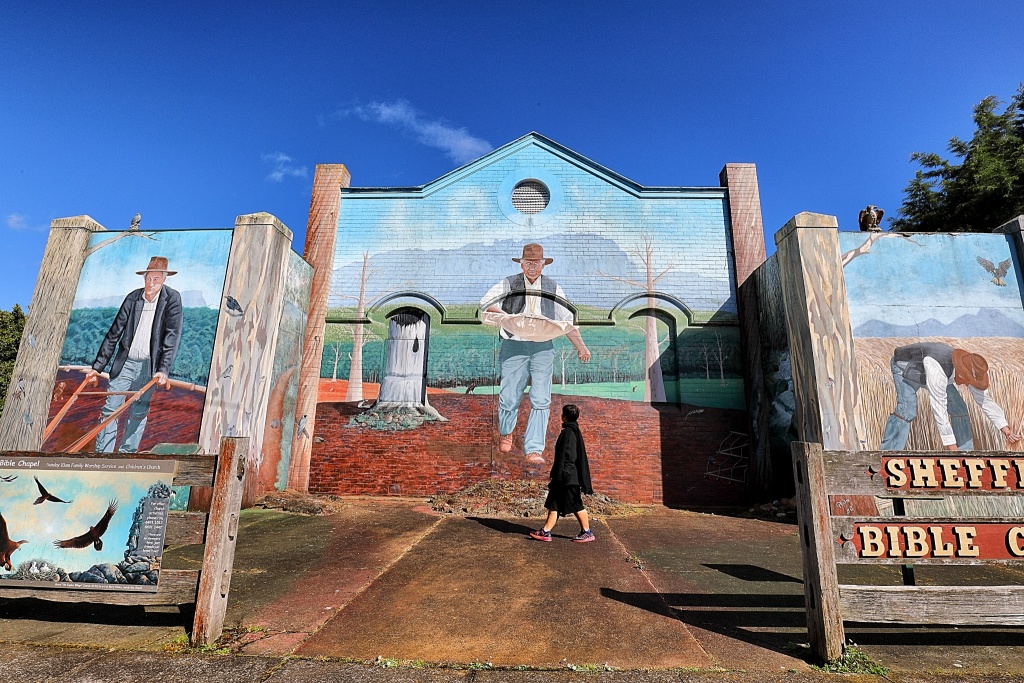
One of the main murals in the town. Makes for an interesting picture opportunity.

Like an outdoor gallery, the wall murals depict scenes of daily life in the town.

The youngsters are also given the freedom of expression here.
Farm produced cheeses @Ashgrove
After the brief pit stop at Sheffield, we headed for the award-winning Ashgrove Tasmanian Farm which specializes in dairy products like cheese, milk, yoghurts etc. Cheese lovers will especially adore this shop which gives a free sampling of several types of cheeses at the shop. Road trippers with children will especially like the shop compound, as the kids can mingle with life-sized painted cow figures.
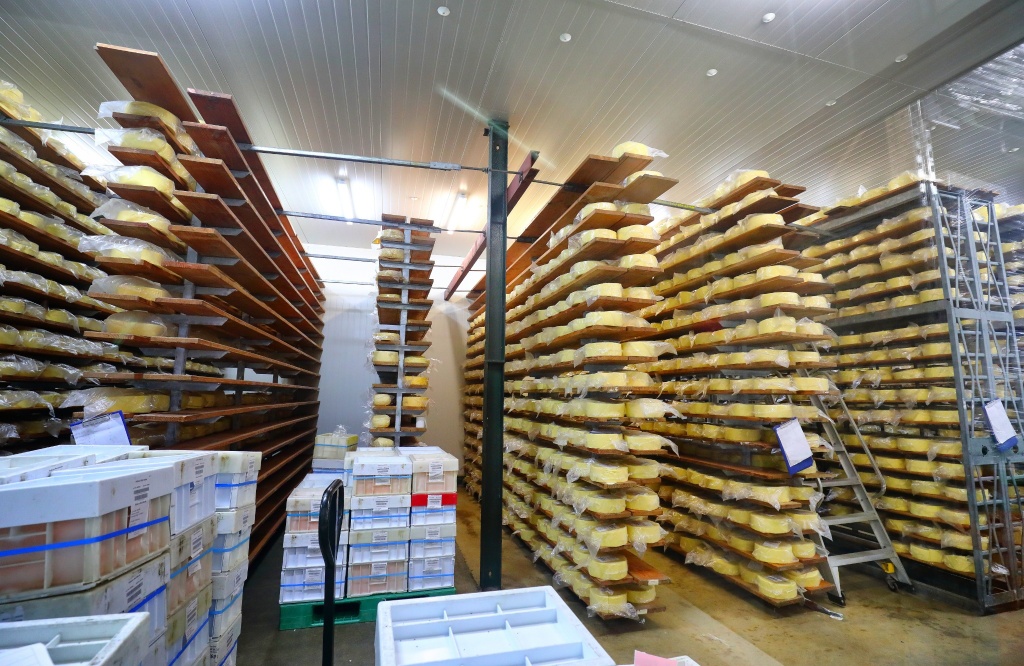
At the cheese curing warehouse, visible from a glass window just by the retail section.

A few cheese flavours for sampling before making any purchase, in a nice clean environment.
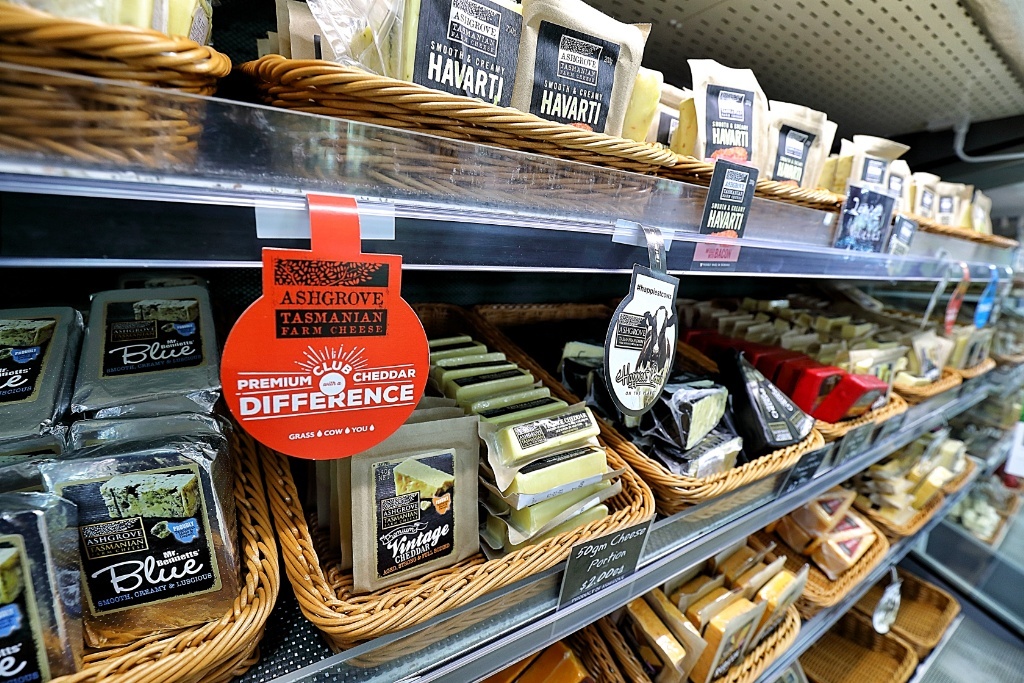
Racks of cheeses with names and flavours that are just too wide to remember. But I think the Blue cheese will agree with most people.
Sweet tooth moment @Christmas Hill Raspberry Cafe
From Ashgrove Tasmania Farm, it took just about a 6min (8km) drive to one of the best pits stops at the beautiful Christmas Hill Raspberry Cafe. Till this part of the road trip, it never failed to amaze me the pretty picture-perfect ambience that the local designers are able to think of, on top of the delectable range of raspberry-based desserts and other menu items available. We ordered their signature raspberry smoothies as well as their confectionery, accompanied by, of course, fresh farm-made raspberry jam. This diner will please everyone and especially sweet-tooth. We also saw a couple shooting their wedding pictures at the picturesque lake and a constant stream of diners coming to the cafe.
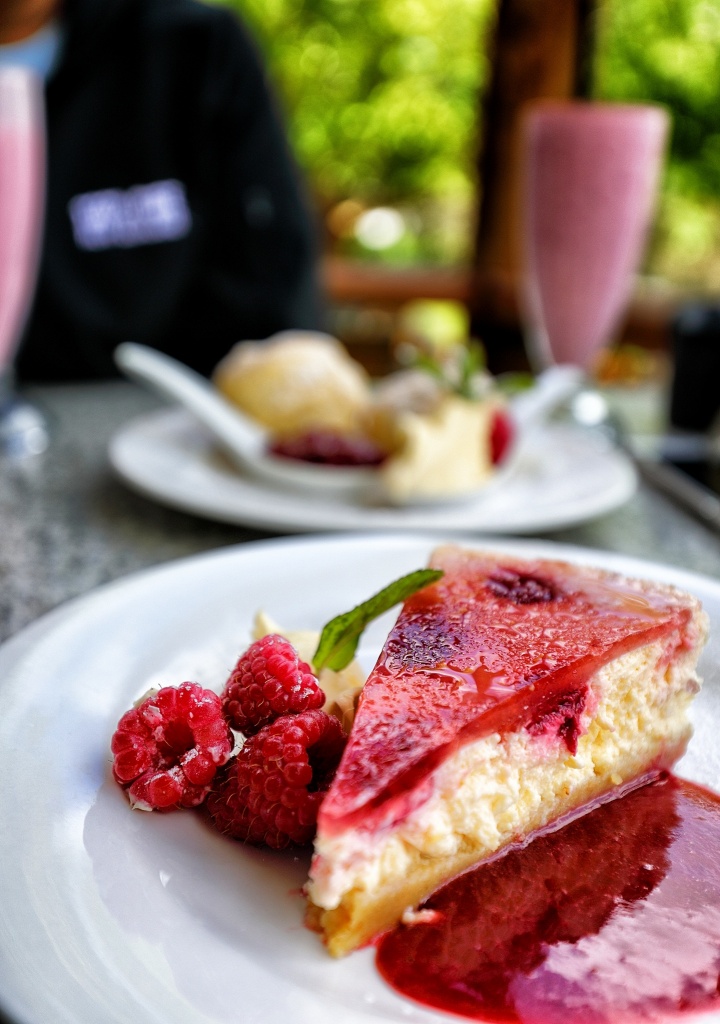
Freshly made raspberry cheesecake with the freshest raspberry sauce. Very nice indeed.
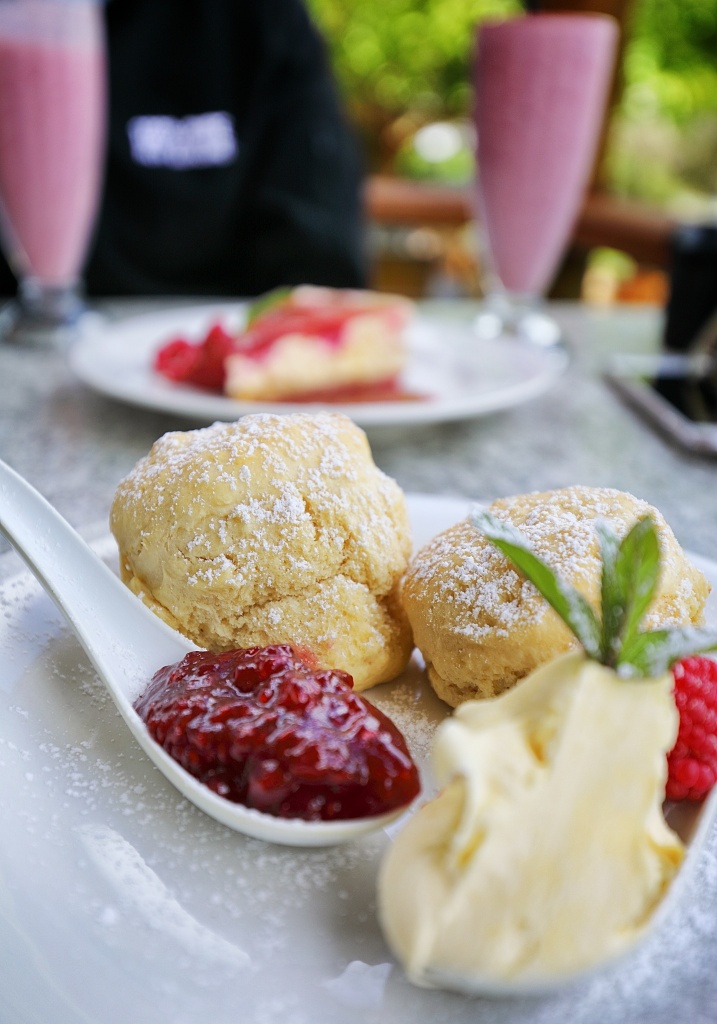
Oven fresh scones with farm-made raspberry jam and cream. Sinful and irresistible.

The raspberry plantation is just across the lake from the cafe. There is no guided tour available but the view is good enough from where we dine at the cafe.
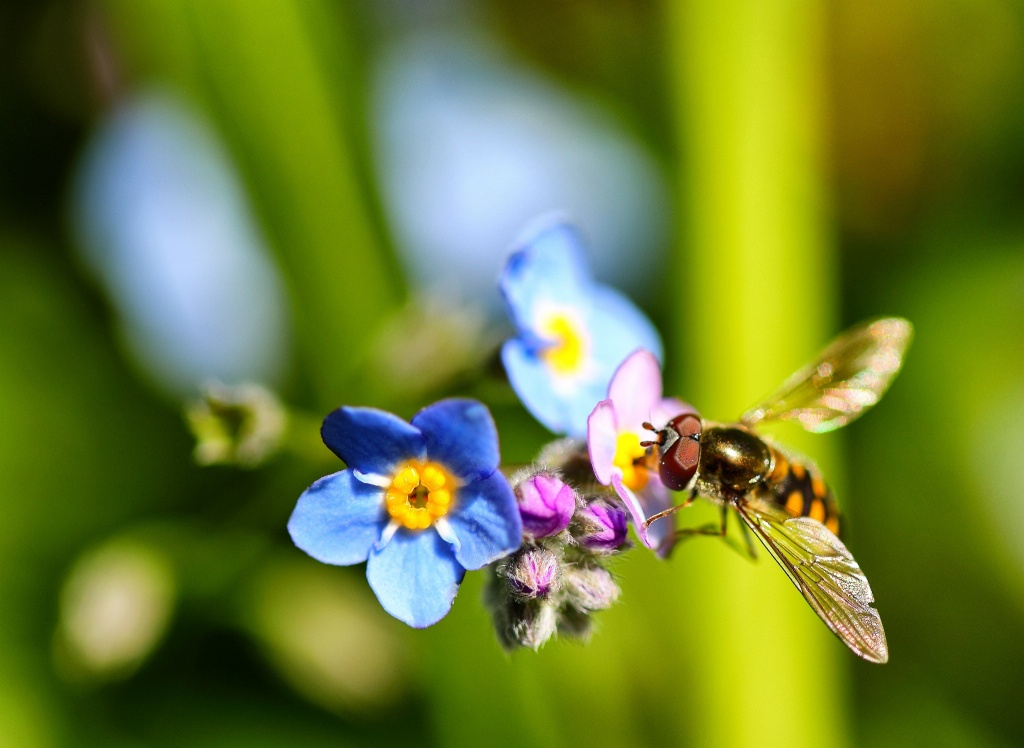
A Hoverfly at the cafe garden. A bee mimics insect, Hover flies are true flies, but they look like small bees or wasps. They are the helicopters of the insect world, often seen hovering in the air, darting a short distance, and then hovering again. These beneficial insects are valuable tools in the fight against aphids, thrips, scale insects and caterpillars.
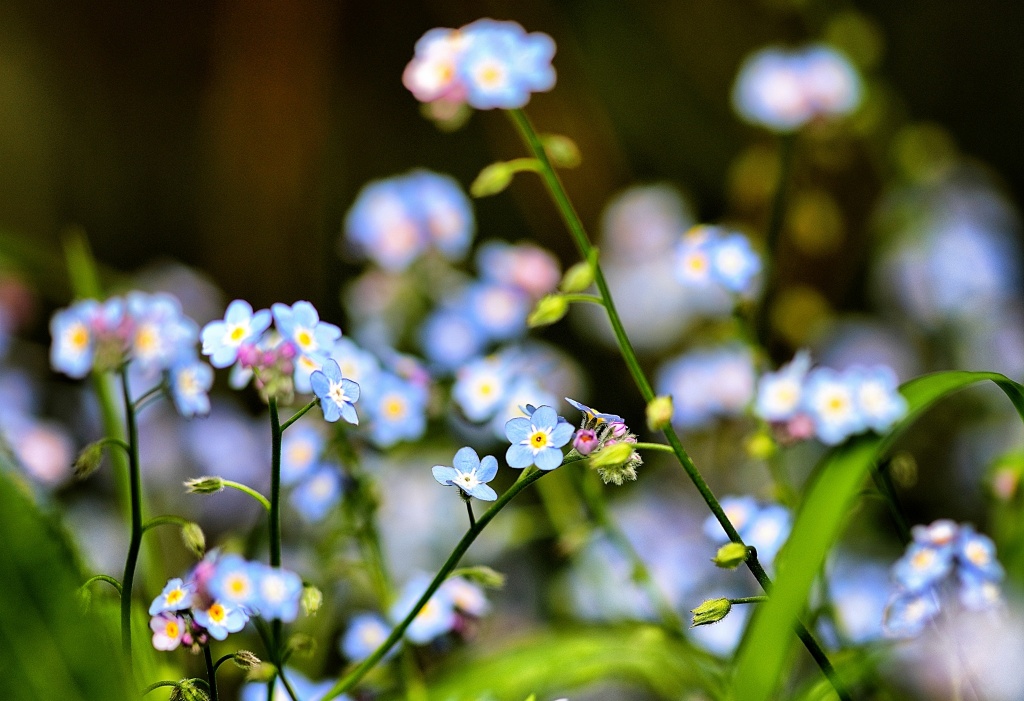
Charming floral and fauna at the cafe compound. Little wonder many couples shoot their wedding pictures here.
Lip-smacking moments @Tasmanian Gourmet Sauce Company
From Christmas Hill Raspberry Cafe, we make haste to visit Tim Barbour, the friendly owner of the Tasmanian Gourmet Sauce Company, just 40min away (60.6km via National Highway 1). Tim has visited Singapore recently to promote his quality homemade condiments, preserves and sauces. His company showcases the art of homemade preserves in a custom-built kitchen near historic Evandale, with the entire production operation HACCP certified to international standards. It was a most delicious lunch that Tim personally cooked, with meats paired so well with his sauces. However, he caters to specific groups of a certain size and not ad-hoc walk-ins. But with his popularity, you might like to check out his schedule so as to partake in the lovely gastronomic session with other visitor groups via his website. You can also buy his homemade sauces, jams and preserves in the retail section.

Tim Barbour, showing us around his beautiful topiary with many types of herbs, grafted fruit plants, flowering shrubs, etc. Apart from being a great cook, he’s a certified landscape artist too.

Great lunch with various homemade sauces to go with our BBQ meat. Each type of sauce lifted the meat flavour in a different way!

Beautiful flowers from the Crassula family, plants with succulent stems and flowers, in Tim’s topiary.
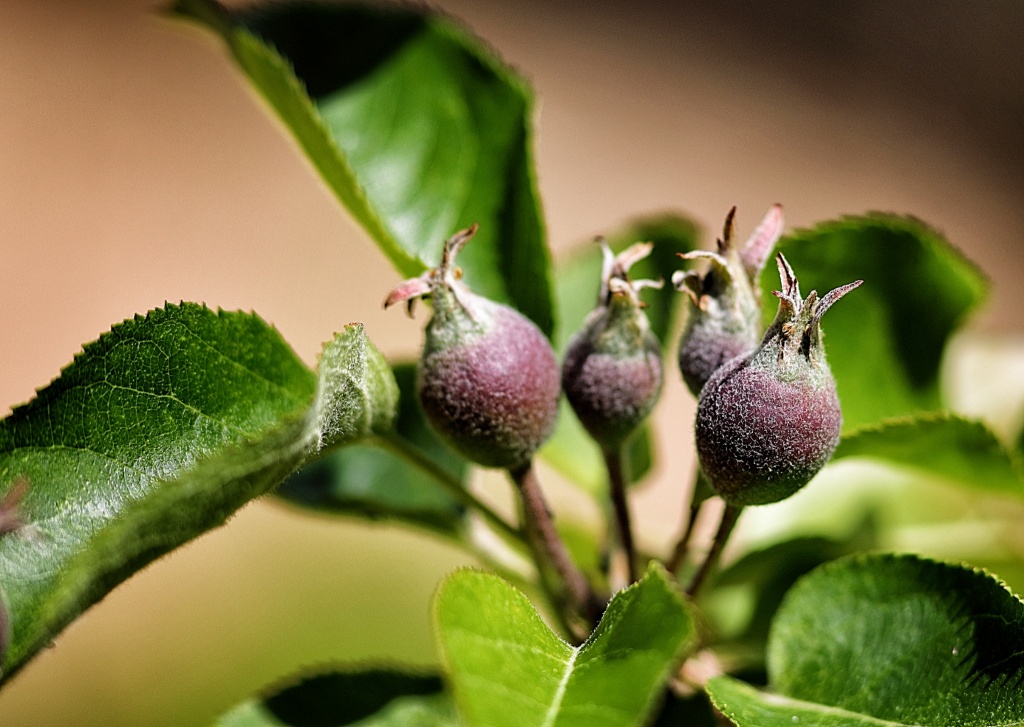
The flowering buds of a grafted apple tree. Baby apples in 1st trimester!
Amazing beachscape @Bay of Fires
Our next destination was Binalong Bay, is situated at the southern end of the beautiful Bay of Fires. This leg of the trip took us on a 3-hour 186km drive. The area is one of the most scenic and beautiful places in Tasmania, from the blue sea and fine white sand to the orange-tinged lichen granite boulders along the coast. The Bay of Fires is one of Tasmania’s most popular conservation reserves. The conservation area extends along the coast from Binalong Bay in the south to Eddystone Point in the north. This is the location that photographers will love for long-exposure shoots using neutral-density filters. The impressive granite boulders, crashing waves, and fast-moving clouds are all perfect ingredients for landscapes with that surreal feel. For nature lovers, there is a wealth of local wildlife to discover, too, including birds that can be encountered on self-guided and guided walks. The area is renowned for game fishing, with numerous boat ramps while offshore reefs have rich marine biodiversity that will appeal to scuba divers and snorkelers.

A heaven for photographers who like surreal seascapes.
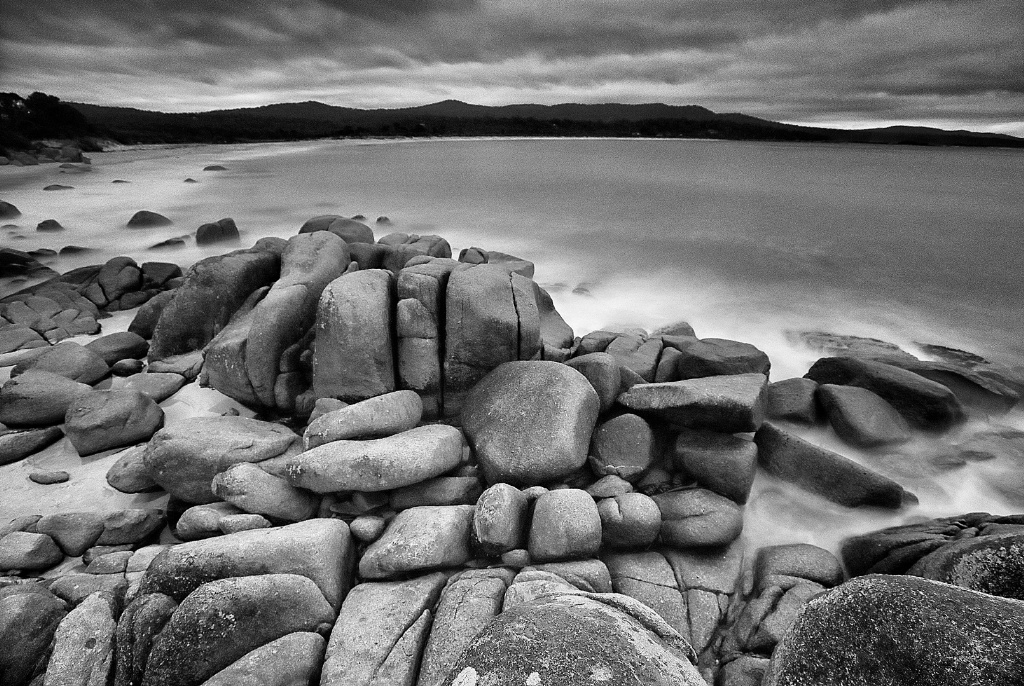
Another part of the beach conveyed in black and white.
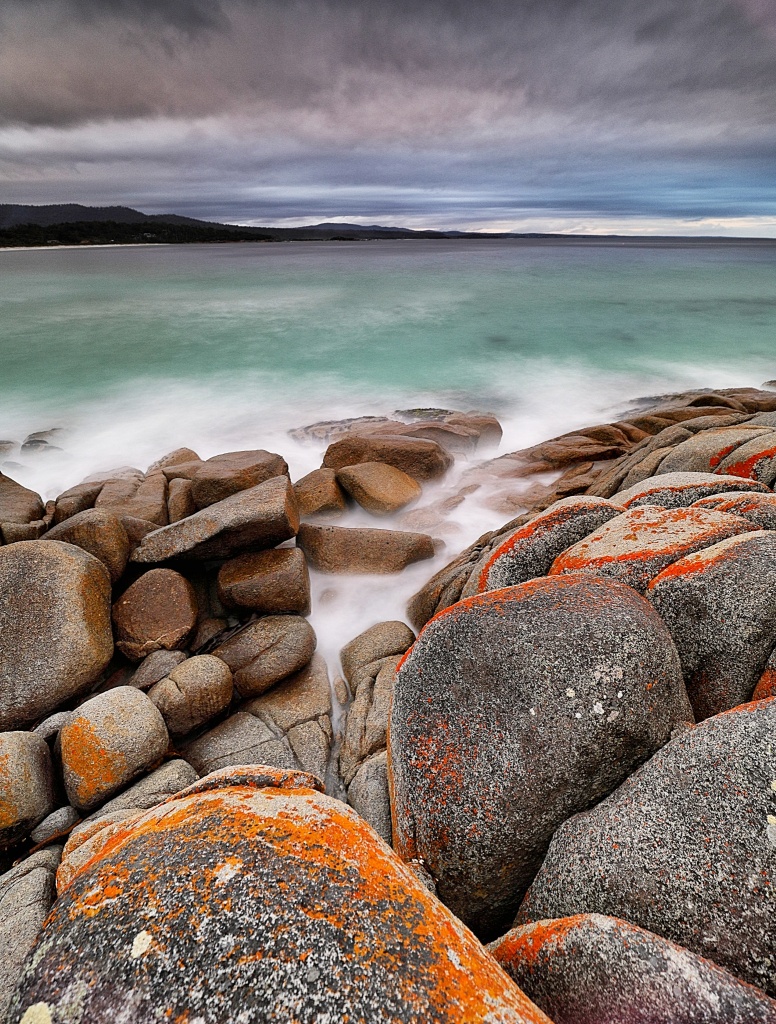
Looking at this orange-tinged lichen on the boulders, I realised why the venue is called the Bay of Fire.

Our choice of accommodation at this leg of the trip, is Tidal Waters Resort, a waterfront-facing resort. The grand plan was to spot the Southern Lights right across the bay, nature willing, right at the room balcony. But we were greeted with heavy cloud cover that night.
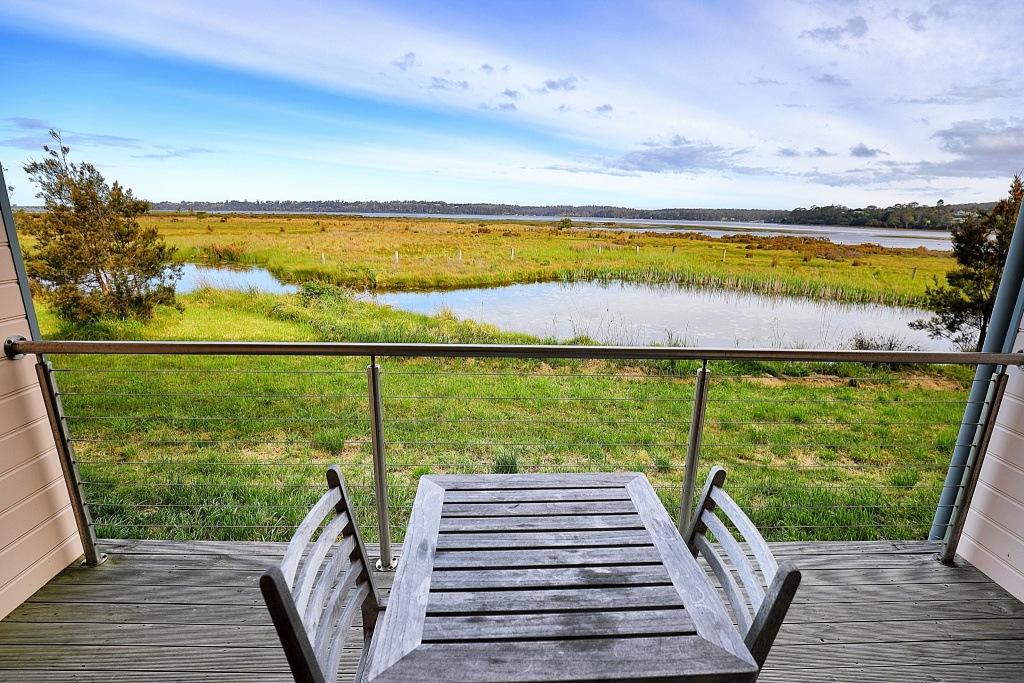
An awesome view awaits us in the morning. Woke up to the melodious chirping of birds and cool fresh air.

Amazing morning lighting beautifies this bed of lavender flowers just outside the resort carpark. Totally entranced and spend half an hour shooting the flowers.

Blooming floral scene at the resort. Make for beautiful memories, naturally.
“Barking Sands” @Four Miles Creek
Along the way to Freycinet Marine Fram for oysters and seafood, we had a chance “discovery” during a toilet break at the Four Miles Creek beach, just a 36min (38km drive) from Tidal Water Resort. This is the first time we heard beach sand producing a whooshing or barking sound when stepped upon with sufficient force. The phenomenon is not completely understood scientifically but it has been found that quartz sand will do this if the grains are very well-rounded and highly spherical. It is believed by some that the sand grains must be of similar size, so the sand must be well sorted by the actions of wind and waves, and that the grains should be close to spherical and have dust, pollution and organic-matter-free surfaces. The “singing” sound is then believed to be produced by shear as each layer of sand grains slides over the layer beneath it. The similarity in size, uniformity, and cleanness means that grains move up and down in unison over the layer of grains below them. Even small amounts of pollution on the sand grains reduces the friction enough to silence the sand (Wikipedia). Other than the interesting find, we were treated to what nature has to offer us… sun, sand, sea and birds. Certainly a lucky pit stop on the road trip.
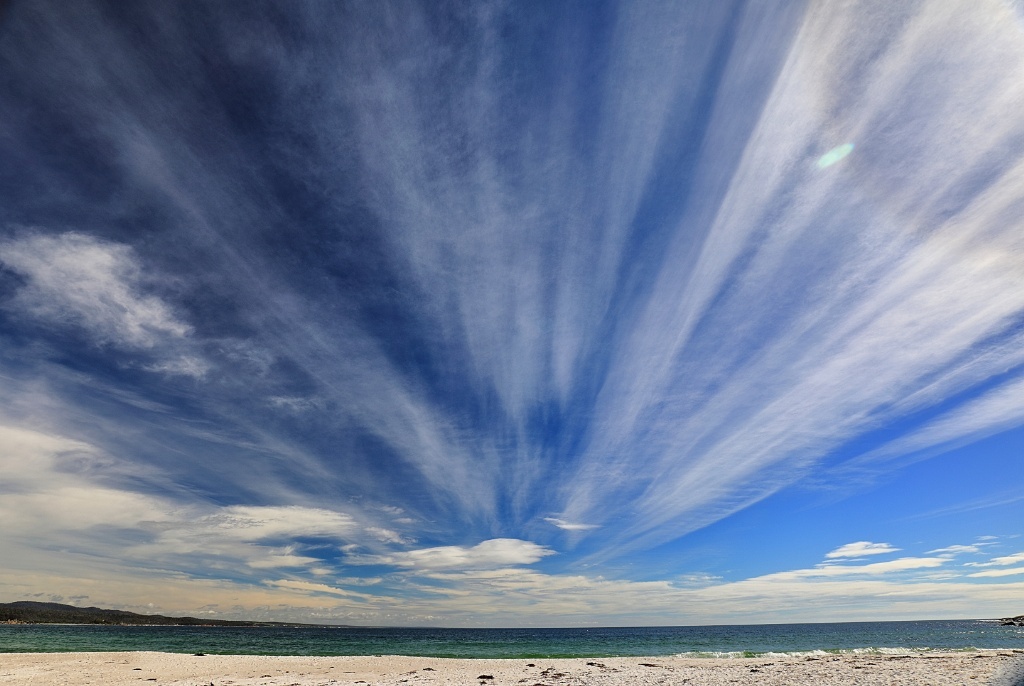
Amazing cloudscape at Four Miles Creek. The shore-bound wind produced spectacular streaky cloud formation.

One of many seagulls at the beach foraging for abundant food among the shoreline.
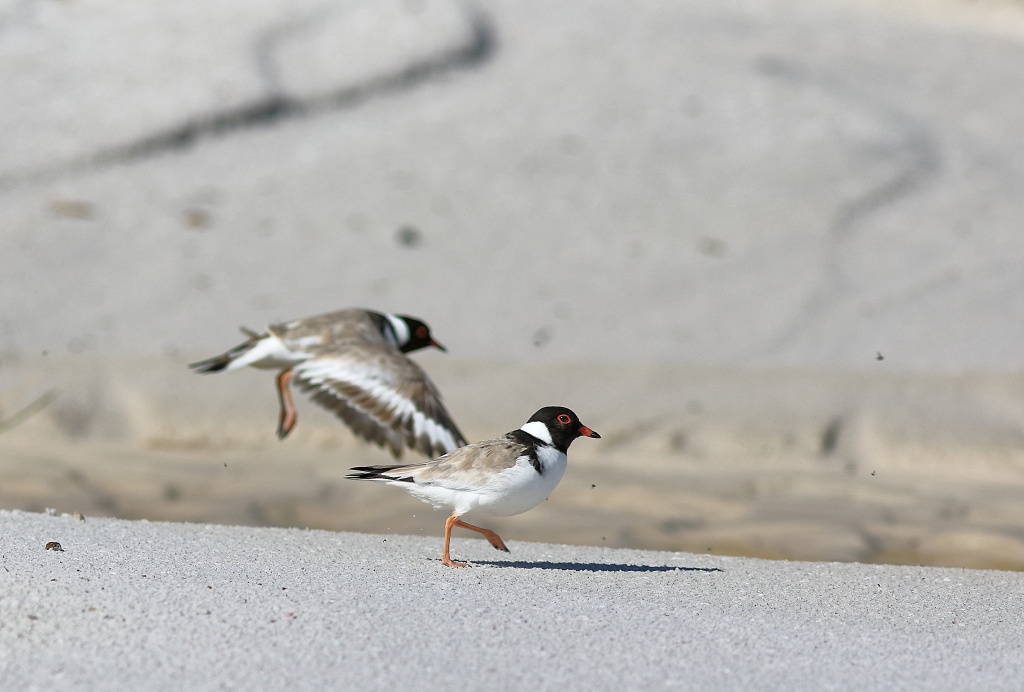
Hooded plover birds keep the seagulls at the beach company. There were a few other colourful birds that we saw on the beach foliage that make us extend our short toilet break to much longer, like half an hour.
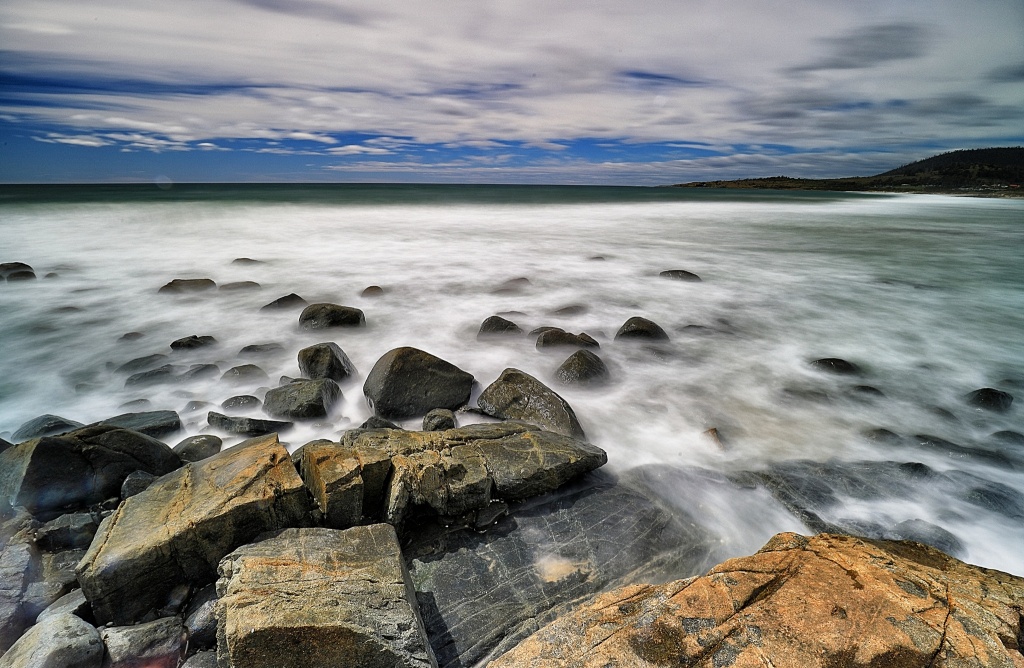
More craggy shoreline for great seascape photography. Just remember to take along that tripod and ND filters.
Freycinet Marine Farm
From Tidal Water Resort, we drove for 1.5 hours over 105km along the scenic highway overlooking the Tasman Sea to savour freshly shucked Pacific oysters at Freycinet Marine Farm. Oysters, scallops, and abalones are some of the most treasured seafood that Tasmania offers and many visitors make a beeline for them. I am not particularly a raw seafood person but still enjoyed taking pictures of the fresh produce of the sea as it lands on the table and fellow diners enjoying the morsel of treasure. Fresh and reasonably priced, it’s a waste to feast on them while in Tasmania.
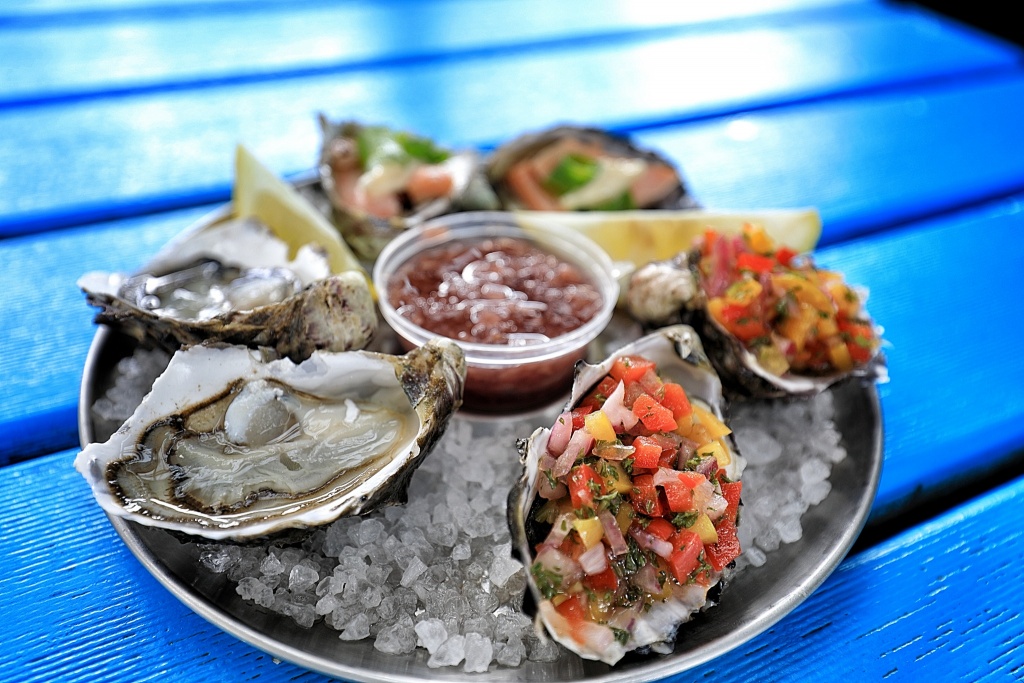
Freshly shucked Pacific Oysters served on a bed of sea rock salt. Took Cindy just minutes to finish the half dozen.
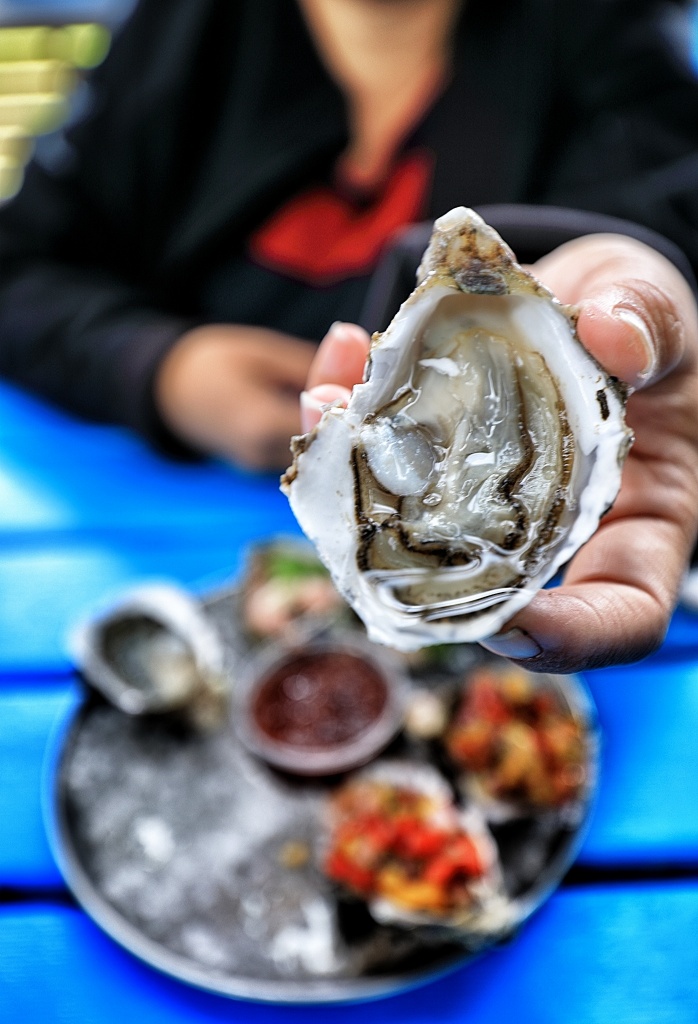
Need to dive into the sea if you want oysters any fresher than this.
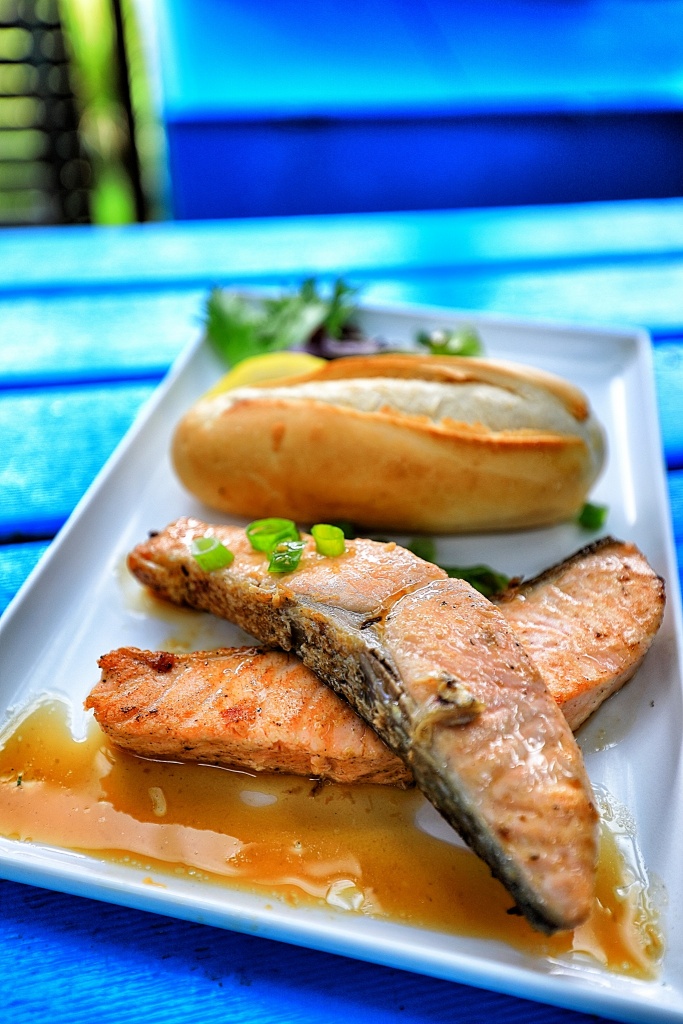
Panfired salmon with toasted baguette. Just as fresh and appeals to non-seafood lovers like me.
Go the high ground @Freycinet National Park
Having filled our stomachs, our next destination was the Freycinet National Park, just about 10min (9.4km) drive away via Coles Bay Road. This beautiful park consists of granite mountains all but surrounded by azure bays and white sand beaches. Freycinet is essentially two eroded blocks of granite – the Hazards and the Mt Graham/Mt Freycinet sections of the peninsula, joined by a sand isthmus. Our main objective at this park was to ascend the peak to view the famed Wineglass Bay. The trek is 2.5km up and down the track which got increasingly steep and can be exhausting. So do factor in sufficient time and hydrate well for this attraction. Readers with aged members or with health issues will be advised to do the Cape Tourville section, just about 7.2km (11min) drive away.

We took quite a fair bit of trekking to reach this peak, overlooking Wineglass Bay. Distance to Lookout point 2.5 km return. The walk commences from the carpark of the National Park and is a 1.3 km ascent up a loose gravel track. While not a long walk, the track is steep at times and winds its way to a rocky lookout, perched between the twin peaks of The Hazards – Mt Anos and Mt Mayson. The dynamic curve of the bay is amplified by the vantage point of the lookout, and it’s a wonderful spot to enjoy a silent moment. Return time is about 1-1.5 hours.
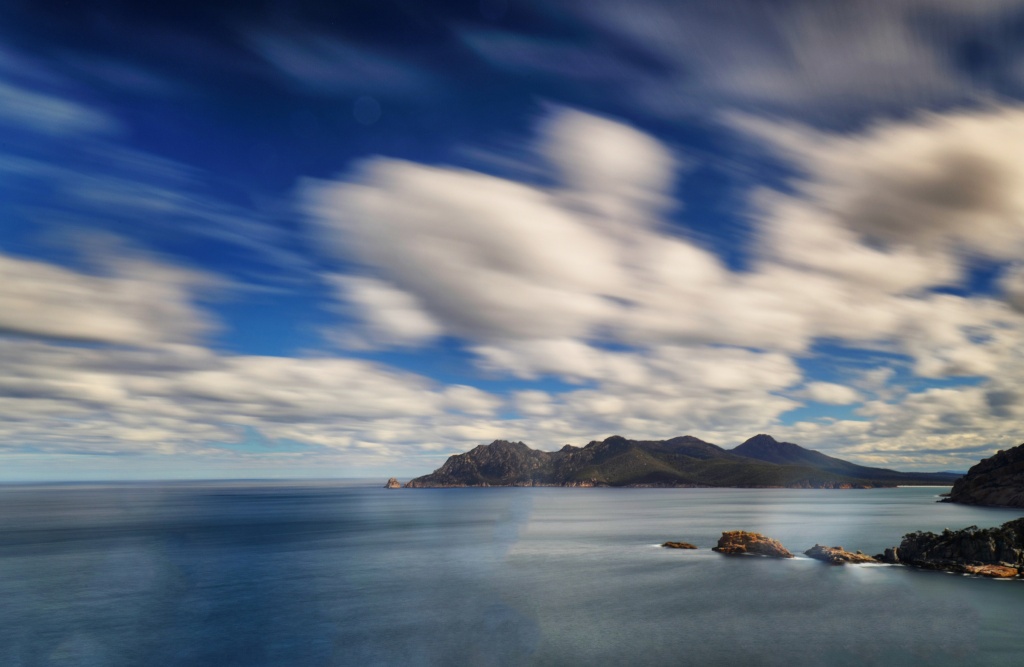
The amazing sea view at Cape Tourville Lighthouse. You can view Carp Bay from the boardwalk, with the Tasman Sea in the distance. The wind here is very strong and do secure your headgear if you are wearing one.
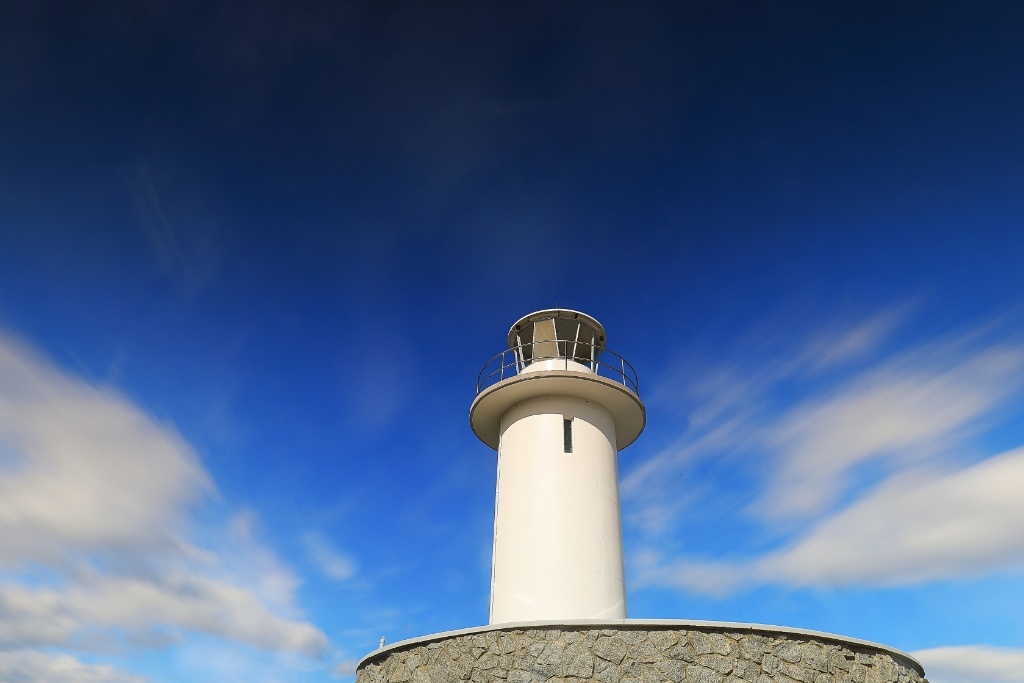
Get up close with the Cape Tourville Lighthouse, against the lovely blue skies and wispy clouds for a memorable picture.

Our accommodation at this leg of the road trip was the Piermont Retreat. This resort deserves special highlight as it’s the best accommodation you can find in the Swansea area. Apart from the luxurious accommodation, of special note is the resort’s fine-dining diner- Homestead Restaurant, which deserves a detour here even if you are not staying at this resort. Great ambience with amazing food.

My dinner of Confit Pork Belly with fennel and orange with was indescribably sinful and delicious.
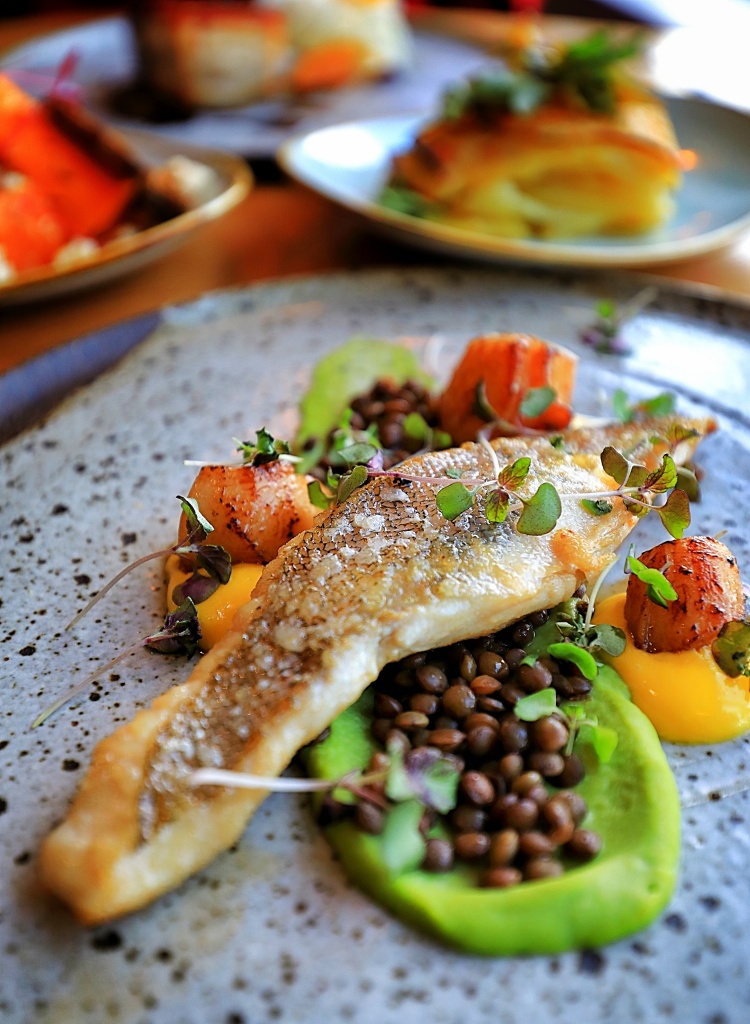
Cindy’s Tasmanian market fish with pea and broad bean salad was certainly an epicurean delight too.

Dusk arrives at Piermont Resort. Effortlessly beautiful and romantic.
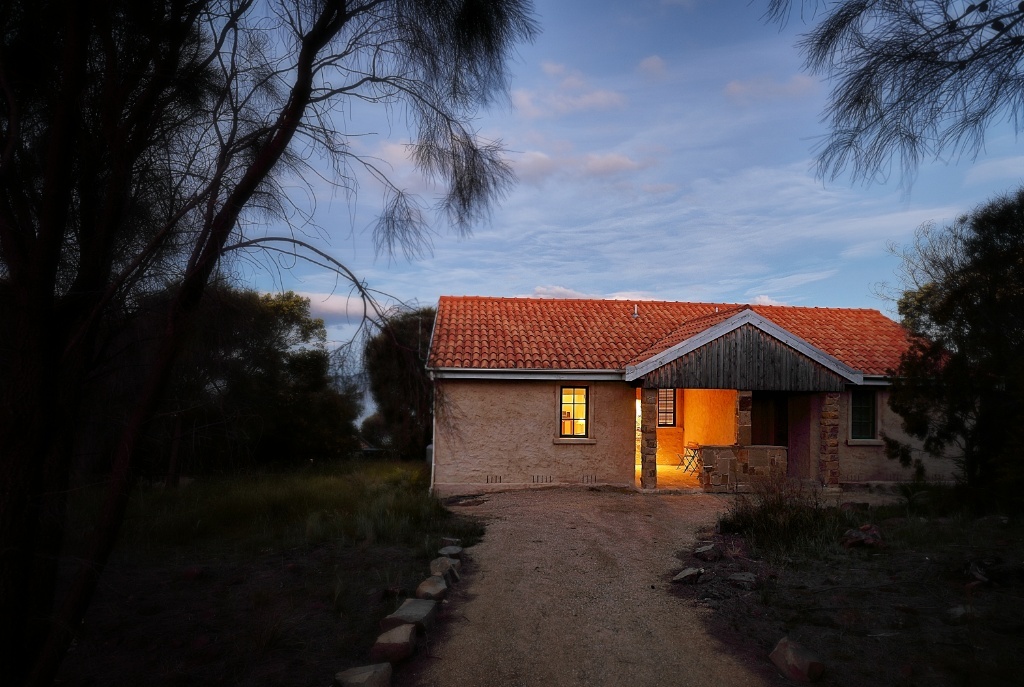
I can’t put better words to describe Piermont Cottages. They are “elegantly furnished with a log fire, jacuzzi bath, full kitchen, laundry and beachfront deck. Built sustainably with natural materials and set in secluded leafy positions. The lush natural surroundings are respectfully framed by Piermont’s suites’ understated European elegance, Tasmanian timber surfaces and neutral hues. Expansive spa bathrooms with sea views and cosy bedrooms provide a luxurious yet uncomplicated base in which to unwind. With daily service, a stay at Piermont’s suites leaves little else to do but rest or explore”. (Piermont’s website)

Spacious room with a beautiful setting and ambience. The bed and linen are the most comfortable I have experienced on the trip so far.
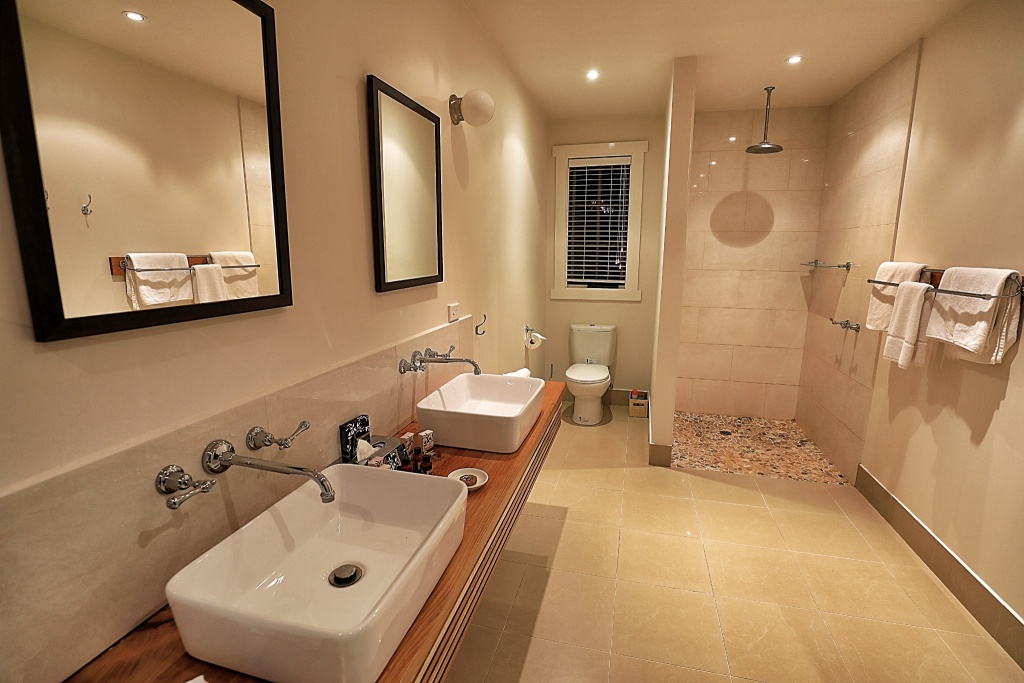
Luxurious bathroom, jacuzzi bathtub and great standing rain shower corner.
Kate’s Berry Farm
The next day, we check out early to enjoy breakfast at Kate’s hugely popular Just Desserts Café, just a 5min drive away from Piermont Resort. Acclaimed for its cool climate, this cosy cafe offers a unique range of mouth-watering quality produce and products that highlight what Tasmania does so well. You can treat yourself to Kate’s Handcrafted Chocolates or taste her unique range of sumptuous jams, sauces and jellies made from Kate’s homegrown fruits. During our meal there, a constant stream of tourists and locals flock to this lovely venue for meals and photo moments.

Gorgeous blooms at the far, with a strawberries farm behind it.

An oasis, Kate’s Berry Farm is located on Tasmania’s stunning East Coast. Kate’s hugely popular Just Desserts Café, with its mouth-watering menu, overlooks rows of strawberries to breathtaking views across Great Oyster Bay to the world-renowned Freycinet National Park. You will want to dine al fresco.

Shot my fave flower picture of the road trip at this farm.
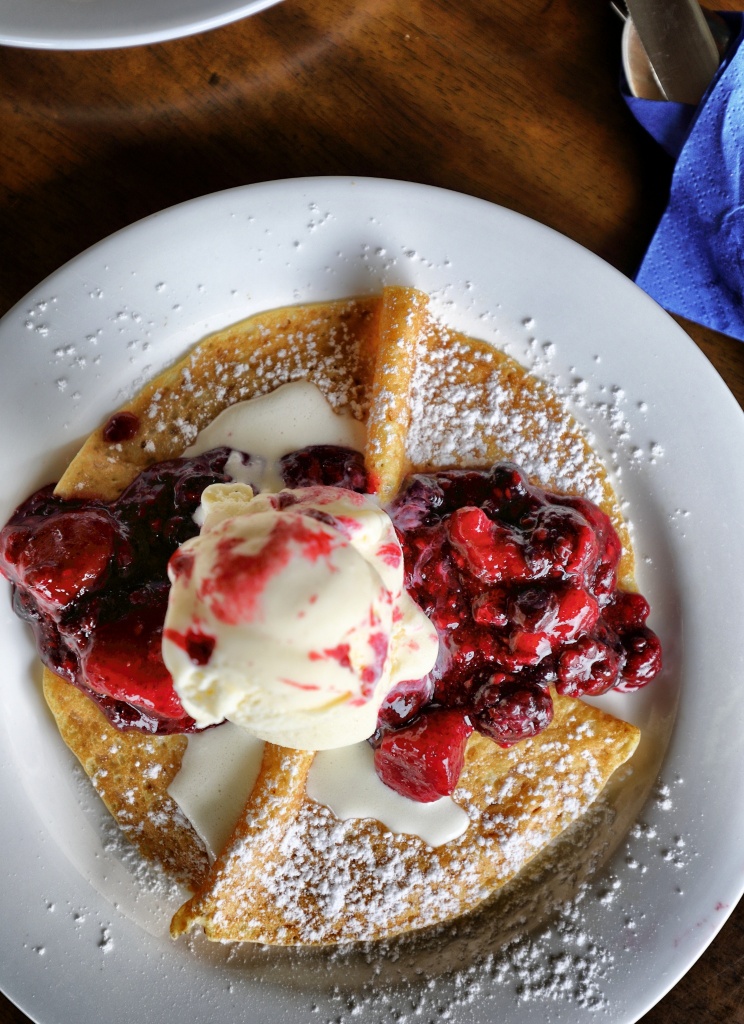
Delicious crepes with farm-made strawberry jam.

Yummy Strawberry ice cream… made right here at the farm…with strawberries grown here.
Richmond Bridge, Tasmania Oldest Bridge @Coal River
After the lovely breakkie at Kate’s Berry Farm, we head in the direction of Port Arthur, which was 155km over a 2.15hrs drive. But along the way, we pay ‘homage’ to the Richmond Bridge, which was 108km (1.5hr drive) away. This bridge is a heritage-listed arch bridge built in 1823. It is the oldest bridge still in use in Australia and the oldest stone-span bridge in Australia. In 2005, the bridge was recognised as an outstanding historic place and added to the Australian National Heritage List. The Coal River runs beneath the bridge and has a nice ‘nature park’ feel, as ducks swim while big catfish forage in the river below. Even colonies of Tasmanian native hens and swans roam about the park. There are also many cosy cafes in the town for a nice coffee break.
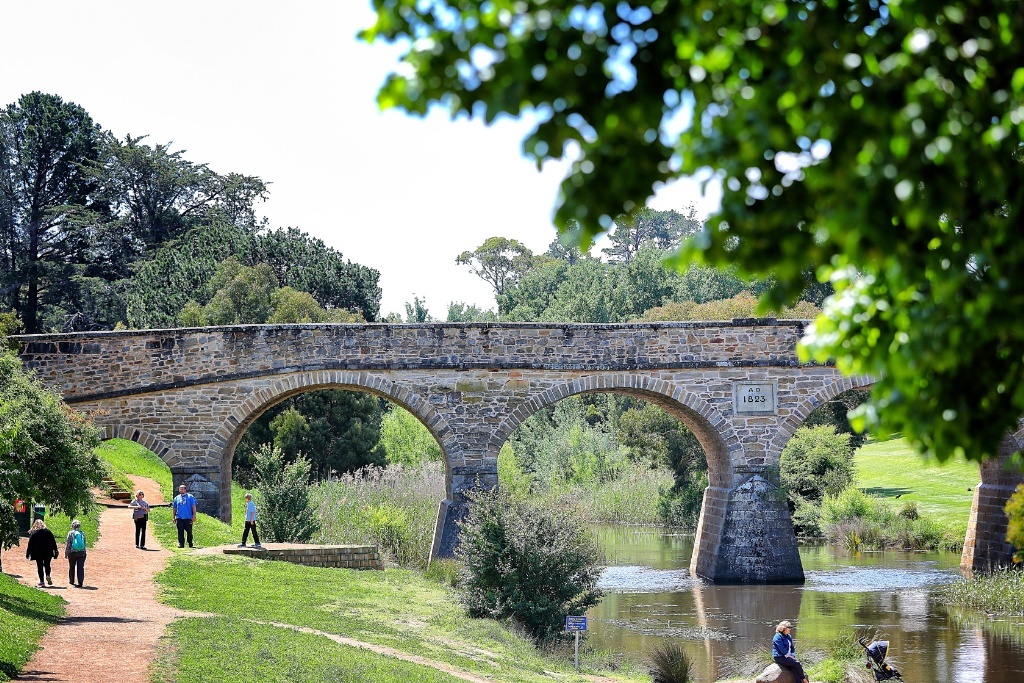
Strawberries picking @Sorell Fruits Farm
From the Richmond Bridge, our next pit stop was Sorell Fruits Farm, just a 16min (15.3km) drive away. As a city dweller, the chance to pluck a strawberry right from its stem is a therapeutic experience. I believe many have picked strawberries at Cameron Highlands in Malaysia. But strawberry picking here is a more casual and relaxed affair as the farm staff don’t go around monitoring us. Tasmania’s cool climate gives extra flavour to its berry fruits and cherries, which are the speciality of Sorell Fruit Farm. The range of berries is wide indeed – strawberries, raspberries, boysenberries, loganberries, blackcurrants, etc. From November to May at least a couple of strawberries are in season, which was the objective of our visit. December and January are the time for picking super-sized sweet cherries. But at different times during the warmer months, you can pick apricots, nectarines, peaches, apples, pears, broad beans and sweet corn. All the fruits and vegetables can be picked at ground level. To take home, there is a wide range of the farm’s award-winning liqueurs and fruit wines, jams, honey, vinaigrettes and pickles – including pickled cherries.
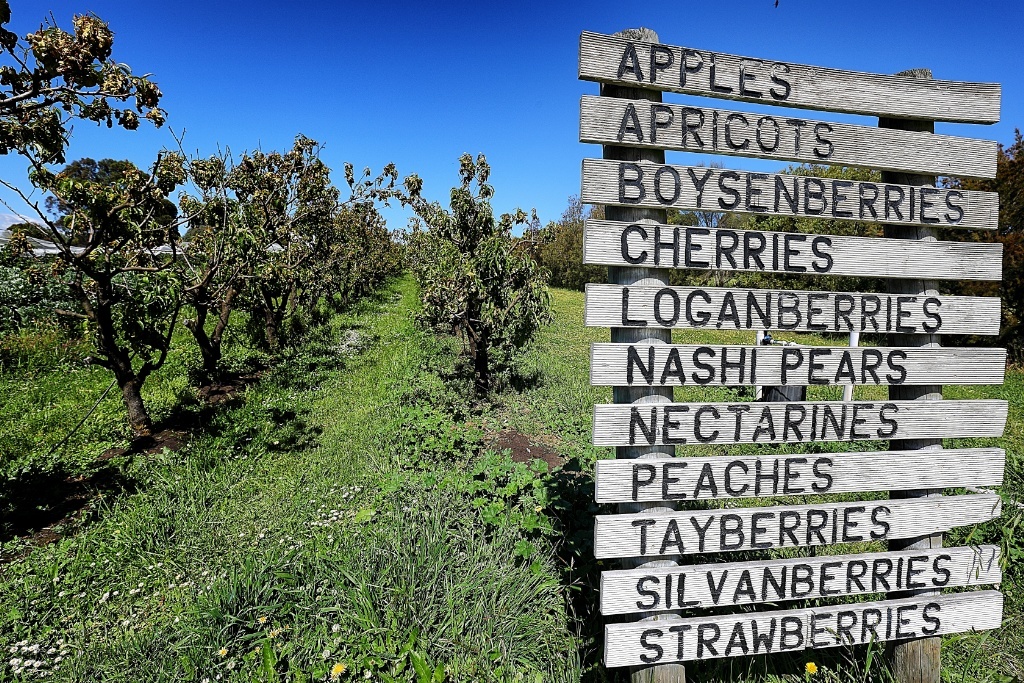
Great variety of fruits grown at the farm, but availability is subject to the seasons.

The wide expanse of the farm, feel free to roam. The fruits are grown at ground level, so lots of squatting is needed to reach your treasures among shrubs.

A lovely sight indeed. Strawberries seem to thrive under the shade of the leaves. We need to pry apart the leaves to get the fruit. But no hurry, the plant is not traumatized or hurt. 🙂

After about 30min, our bountiful harvest. Looks like loads of Vit C snacks along the road trip after this.
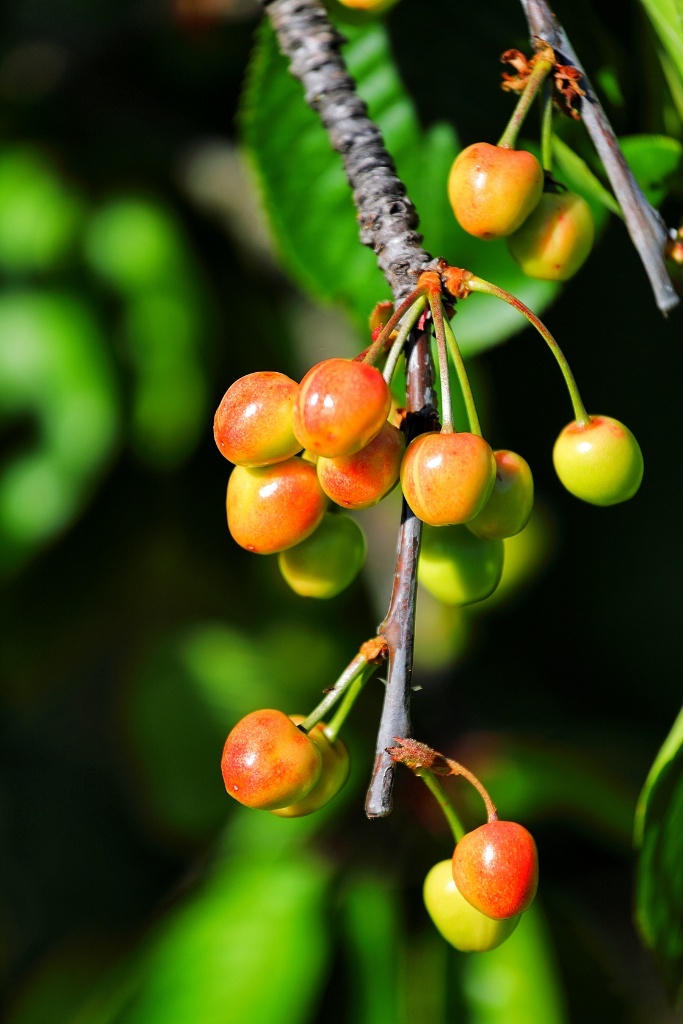
Cherries coming into the season, but are not fully ripe yet.

Some peaches on the tree…but still not ripe for picking. But still lovely looking at the fruits.
Amazing seascape @Dunalley
Another lucky discovery on the road trip. After a 30min (33km) drive to Port Arthur direction, we chanced the amazing seascape at Dunalley, which is a quiet fishing village known for its super-fresh seafood. Located near a narrow strip of land that connects the Forestier and Tasman Peninsulas with the rest of Tasmania, Dunalley is peaceful and pretty with beautiful bay-side scenery. We did not stop over at Dunalley but were instead attracted by the amazing seaside scenery at low tide, where the sand ripples created an interesting surreal landscape. This was shot at 3.30pm during a drive-by, during which we made an unscheduled photo pit stop. As this is a chance occurrence subject to tides, we were immensely fortunate to witness this beautiful scene.
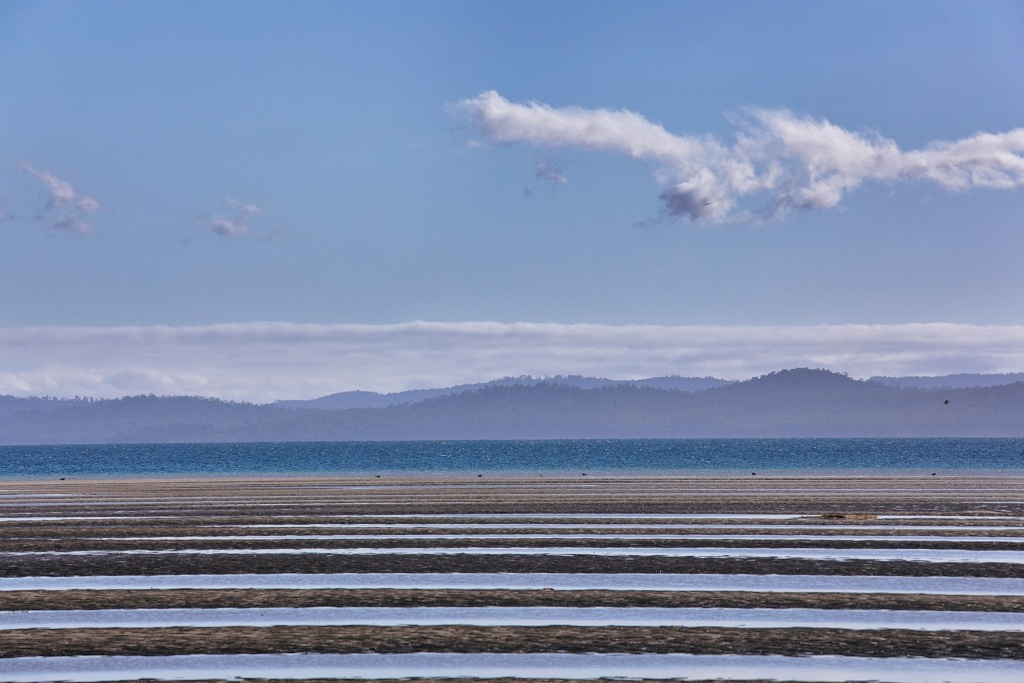
Surreal landscape at Dunalley. It was totally an unscheduled pit stop but so glad we witnessed this.
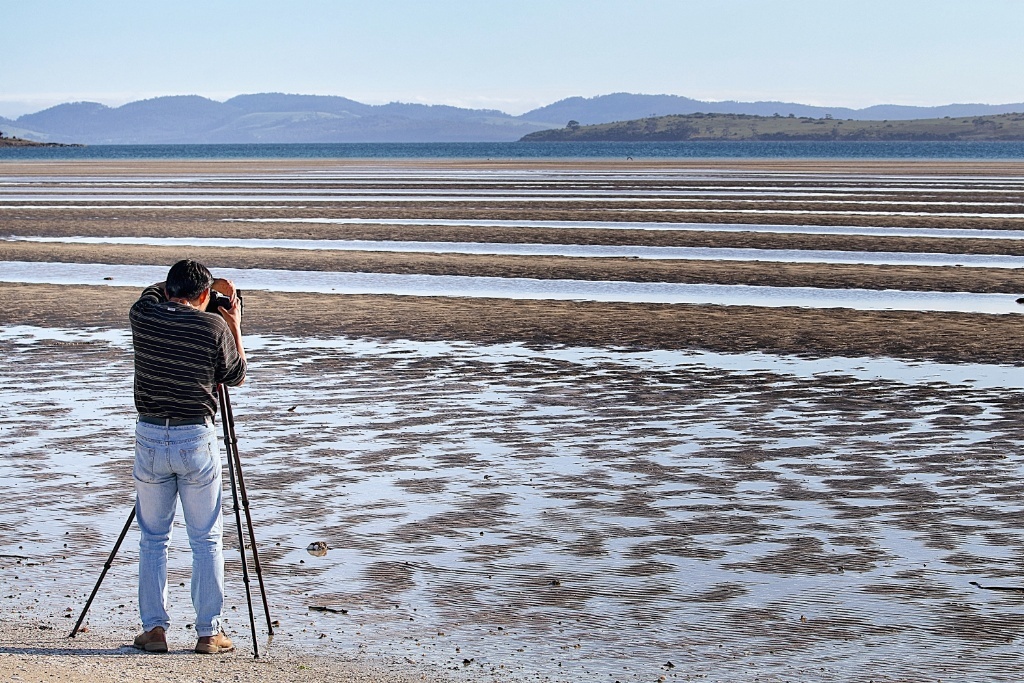
Yours truly at shooting the landscape. Felt so lucky we were at the right time.
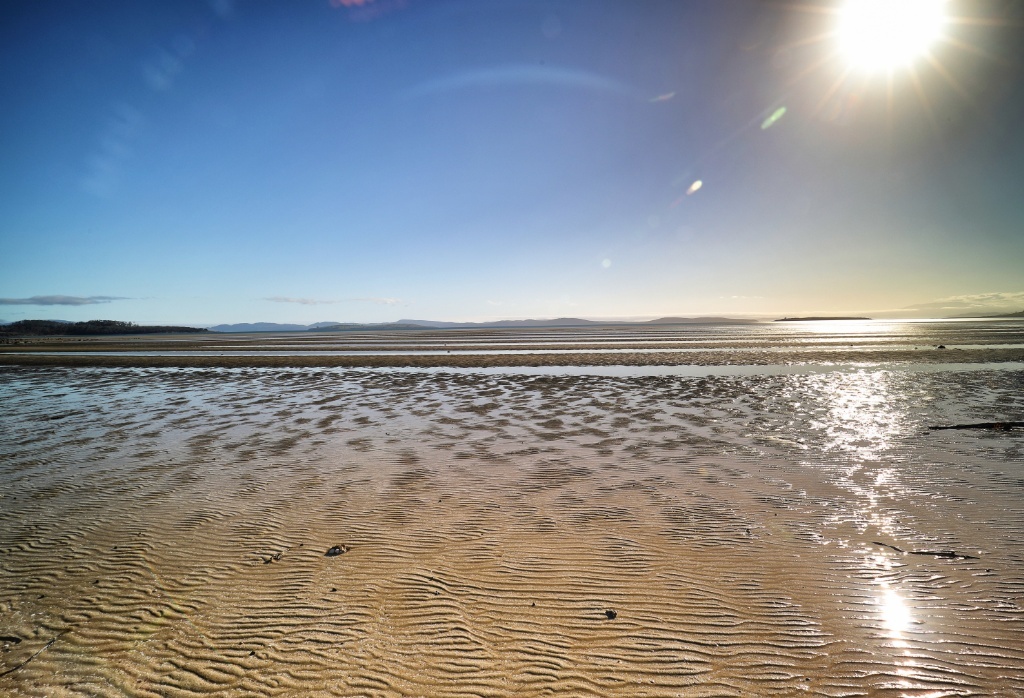
Tides coming in. In a moment, all that unique landscape would have disappeared.
Unique works of nature @Tessellated Pavement, Eaglehawk Neck.
From the quick photo session at Dunalley, we next make haste to the Tessellated Pavement, just 18 min (20.1km) drive away. This is a most unusual attraction, where a part of the shore is covered in a pattern of regular rectangular saltwater pools. Although these depressions look distinctly man-made, they are the result of a rare type of natural erosion. Occurring near sea coasts on a flat rock which has broken into regular blocks, the effect is known as “tessellated pavement” for its resemblance to Roman mosaic floors. The pavement takes two forms. Depressions are known as pan formations, occurring when saltwater wears away the centre portion of the stones into pools. The opposite effect is known as a loaf formation when the edges of the stone are worn away leaving a rounded crown resembling rising bread. Tessellated pavement is extremely rare, found only in a few places on Earth.
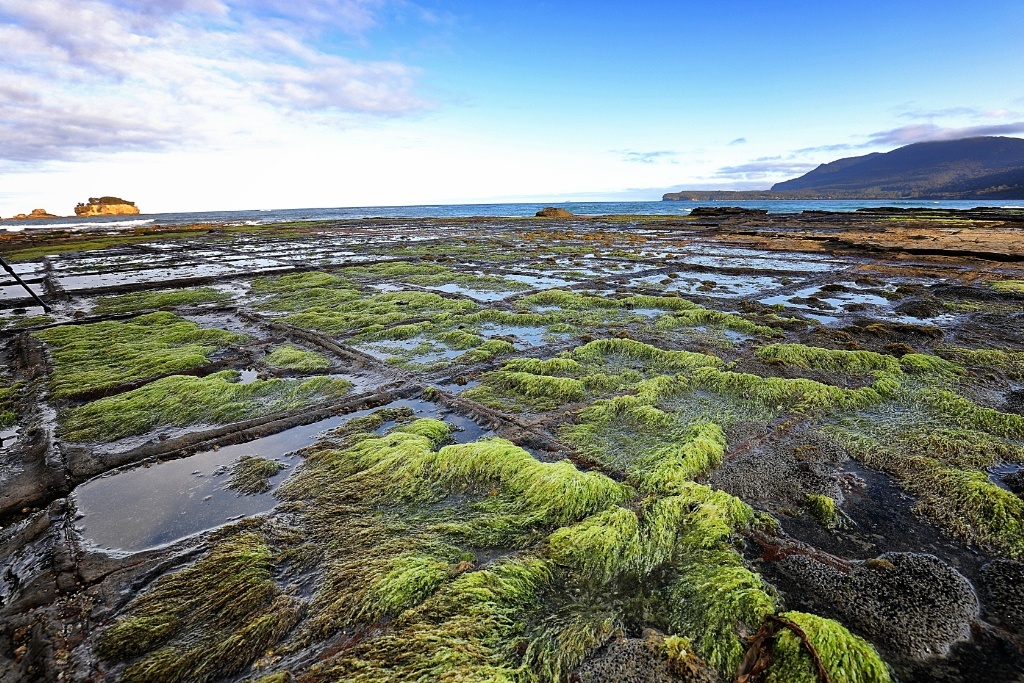
Amazing works of nature, right there in front of us. Before I researched and was clueless about this crisscrossed rock feature, I had the impression that it was some sort of ancient ruin as the structure really looked man-made. But the realization of this as works of nature made me all the more impressed with how much nature has festooned this gorgeous island.

Precious Mother Nature’s Works of Art, all laid out for us to enjoy. Truly a privilege to see this rare natural occurrence estimated to be between 60-160 million years old.

Yours truly, with a picture shot by Cindy. Trying my best to get the best angle at the venue.
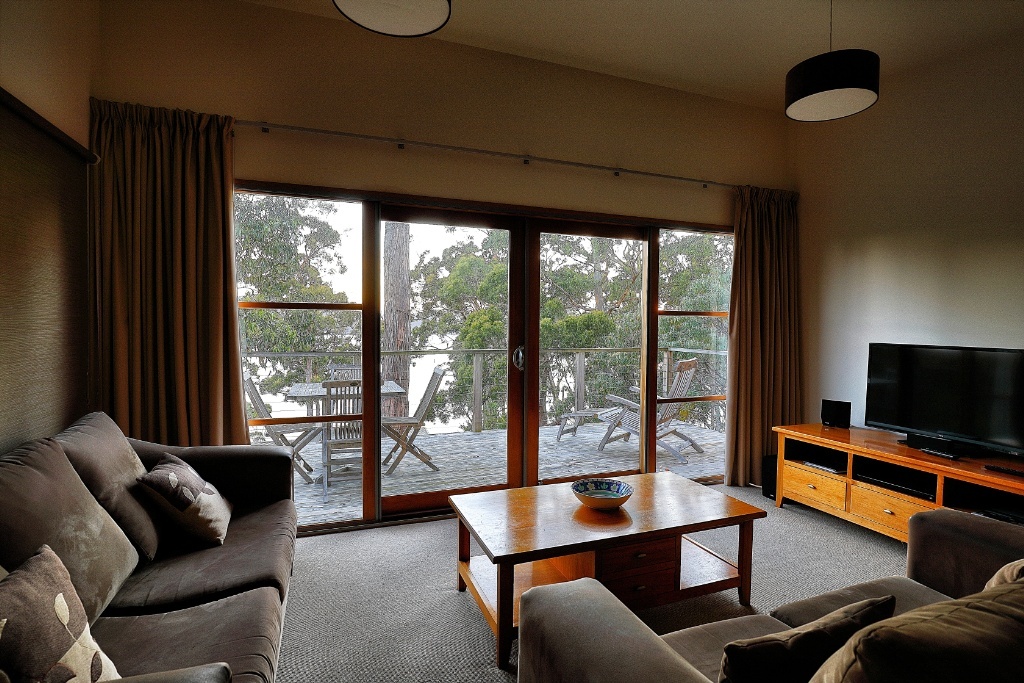
Our choice of accommodation at Port Arthur – Stewart’s Bay Lodge, a cosy, well thought out and fully equipped lodge. As this was on day 16th of the road trip, the washing machine with dryer was the most appreciated at this moment. The resort is surrounded by a white-sand beach, crystal-clear ocean waters and beautiful woodlands. Our hope for another night of Southern Lights ends here as the next hotel would be in Hobart city, where light pollution from city lights negates any chances. But as Mother Nature decided, the thick clouds cover that night meant Lake Pedder remained the only place we had the luck to see the Aurora Australis.

Our last morning at Port Arthur rewarded us with a pleasing nature moment, when a seagull landed on my lodge balcony, giving me that intense look and never fly away even though I approached it. I guessed some bread and strawberries satisfy its hunger pang and I convinced him (or her) that most human beings just want to be friends, like many other resort guests who fed her.
Port Arthur Historic Sites
The next morning, we checked out early and reached the World Heritage-listed Port Arthur Historic Site, after just a 2-3 minutes (1km) drive. This is Australia’s most well-preserved and evocative convict site and a must-visit destination on any tour of Tasmania. This huge former convict settlement was built in the 18th & 19th centuries to house convicts and re-offending criminals in the early days. It now has over 30 buildings, ruins and restored period homes set in 40 hectares of landscaped grounds. It’s isolation and formidable geography gave it a feared reputation. After transportation of convicts ceased, the buildings were used for many years to accommodate convict invalids, paupers and ‘lunatics’. The site has continued to evolve through phases of significant development, decline and change, bushfires, theft, demolitions, constructions, major landscape alterations and restoration work. The site entry tickets are valid for two consecutive days and include an Introductory Guided Walking Tour, Harbour Cruise, access to the Museum, Convict Study Centre and Interpretation Gallery and the site of the Dockyard. For a small additional fee, you can also cruise to the Isle of the Dead and join a guided tour of Port Arthur’s island cemetery or take a tour of Point Puer Boys Prison, the first reformatory in the British Empire built exclusively for juvenile male convicts. This is quite unique

The Old Penitentiary, lots of old tales there.
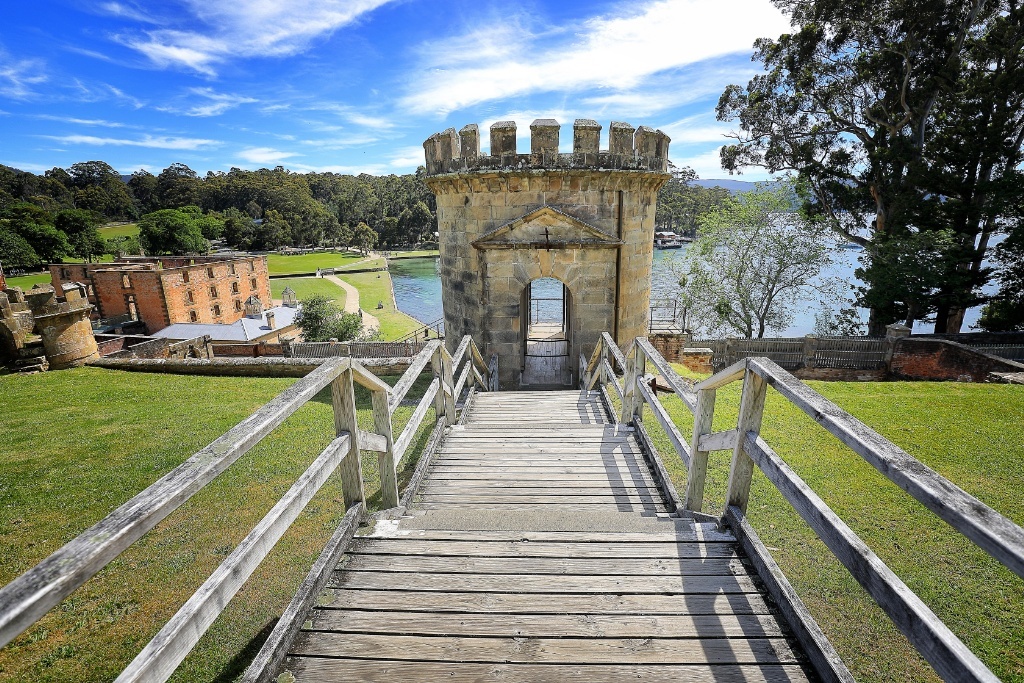
The Look Out Tower, in the past, was used as the eye to the whole place, any prisoners escaping will be spotted from there.
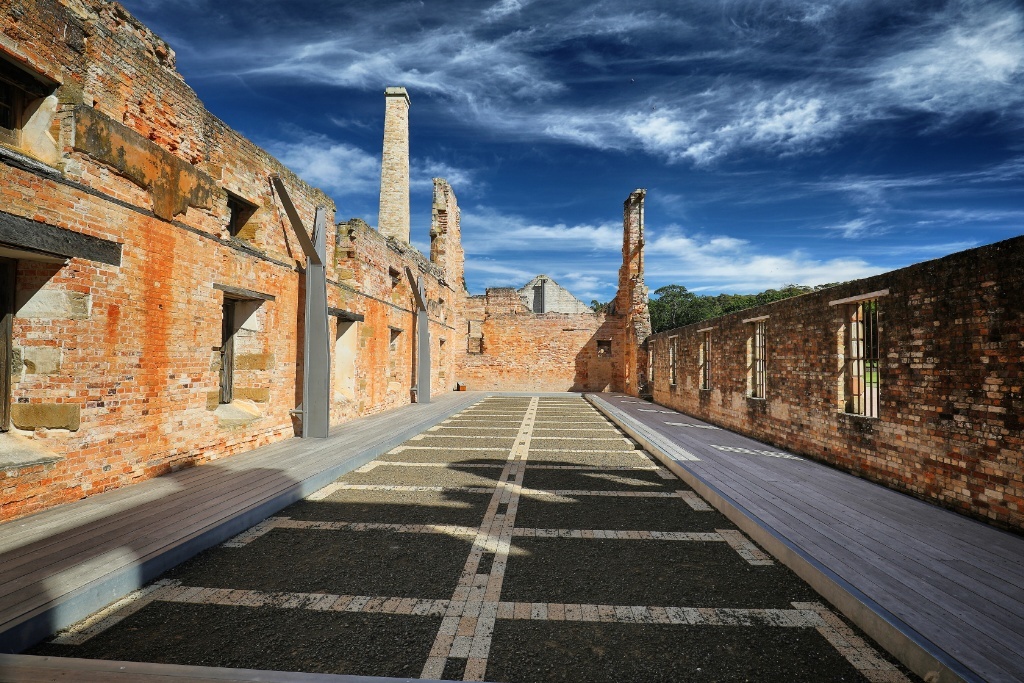
This used to be a prison here. Notice the cells are marked on the ground for reference.

An interesting observation here was the colonies of swallows that have taken residence in the nooks and crannies of the preserved buildings. This is one of the rare occasions I had the chance to go close and shoot pictures of them, as they perch on the building ledges.
Avant Garde moments @Museum of Old and New Arts(MONA)
From The Historic Sites at Port Arthur, our next destination was Mona, the Museum of Old and New Art, located in the Berriedale peninsula in Hobart. The straight journey would take about a 1.5-hour drive over 103km. Along the way, we stopped at the Eagle Hawk Neck Blowhole for a quick look but did not see much activity of interest and had lunch at Barilla Bay Oysters. This phase of the road trip marked the tail end of the epic road trip and it’s like returning to city life from an adventure to the Tasmanian “outback”. And I must admit to having an “ignorant moment” yet again. As I did not research this attraction before the trip, my impression of MONA was that of a museum, worth just a quick jaunt, no big deal. But it is this ignorance that serves to kick me out of my stupor. Ignorance is bliss sometimes and it keeps my plate clean for all that was to splatter on it. MONA is not about Mona Lisa, it’s one of the most spectacular art museums you will ever come across! Period.
This venue opened officially in January 2011 and is Australia’s largest private museum and houses a diverse private collection that ranges from ancient Egyptian mummies to some of the world’s most infamous and thought-provoking contemporary art. The building’s subterranean design and the owner’s unconventional and challenging curatorial approach make it a must-see for any visitor to Australia, and may I say again.. .. a “MUST SEE”. For those keen in photographing the art exhibits, it is allowed but strictly no flashlight is permitted.

Entrance to the art museum. The museum is designed like a subterranean structure, where after entry, take the lift to the lowest level and basically ascent each level of art exhibits as you progress.

At the basement level entrance, observe those walls and cavernous ambience, you are in for a visual assault. One that you will savour and remember.

Amazing Words Waterfall by Julius Popp. One of the most spell-binding exhibits…

My fave exhibit of the entire museum…by Japanese artist Yayoi Kusama, a Japanese artist and writer. Throughout her career, she has worked in a wide variety of media, including painting, collage, soft sculpture, performance art, and environmental installations, most of which exhibit her thematic interest in psychedelic colours, repetition and pattern. A precursor of the pop art, minimalist and feminist art movements, Kusama influenced contemporaries such as Andy Warhol and Claes Oldenburg. Although largely forgotten after departing the New York art scene in the early 1970s, Kusama is now acknowledged as one of the most important living artists to come out of Japan and an important voice of the avant-garde.
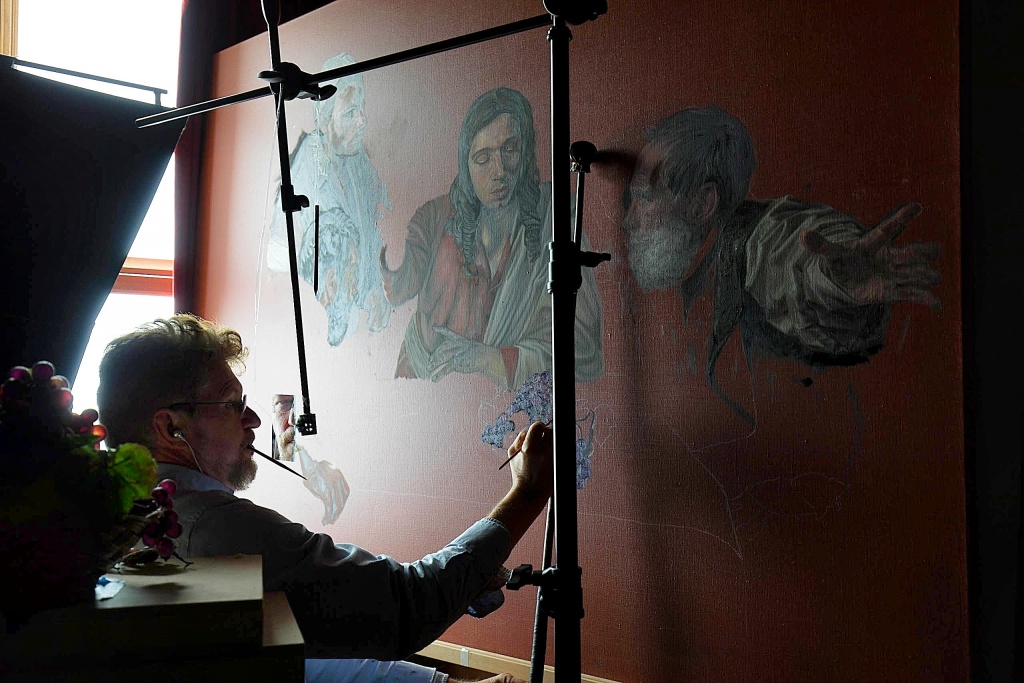
An artist performing recopy work. A treat to see an actual artist at work.

Loads of talented artists’ works, do factor in at least 3-4 hours for this attraction..longer if you appreciate art immensely.
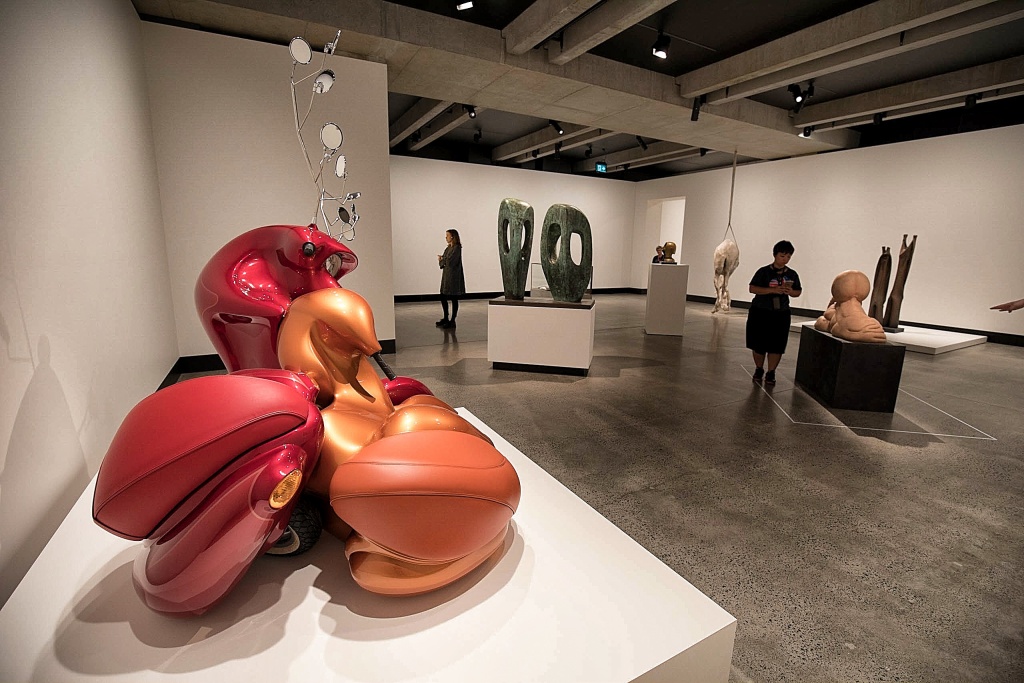
Scooters transformed into a work of art.

Introspective bust head on the human psyche.

Towards the end of the visit, an immense wall of art collages greets you, cementing that spell-binding feeling. You will want to return again on the next trip.
The Henry Jones Art Hotel
After our visit to MONA, it’s just befitting that the artsy experience continues with our accommodation at The Henry Jones Art Hotel. This quaint hotel is a fusion of history and modernity, art and design, indulgence and discovery. Australia’s first dedicated art hotel, The Henry unites one of Tasmania’s most significant industrial heritage sites—H. Jones and Co. Pty. Ltd. IXL—with modern design and contemporary art to create a luxurious accommodation experience. I strongly recommend this lovely hotel for their stay in Hobart.

The hotel facade, lighted by the late afternoon sun. Conveniently located among many eateries and amenities at Franklin Wharf.

The hotel lobby. Felt like an art gallery?

Walkway to the rooms. Artsy and dignified.
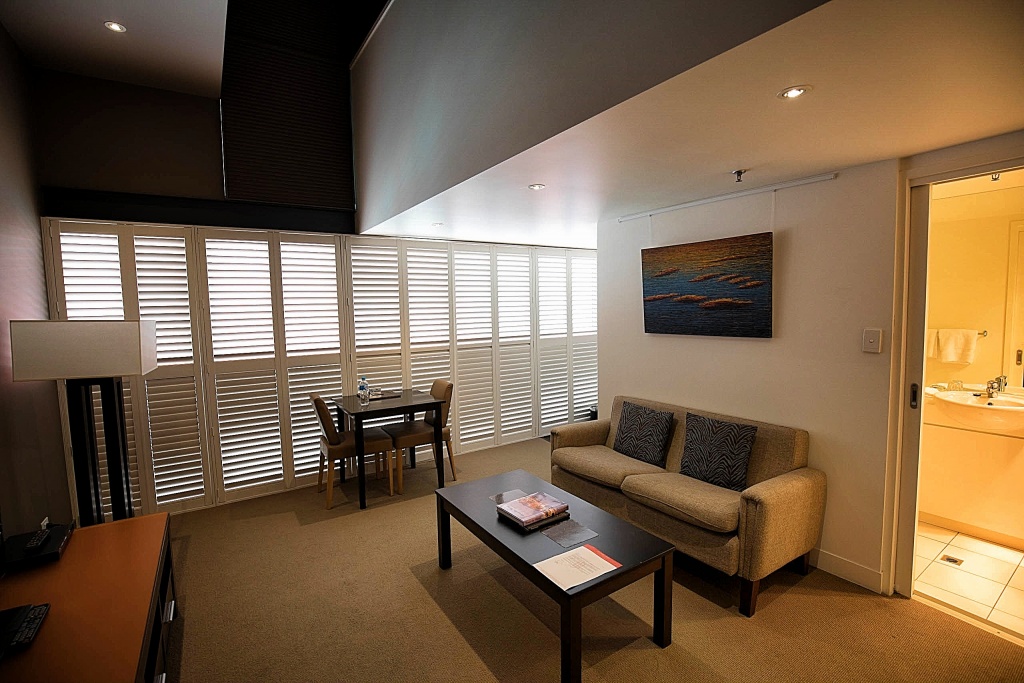
My room for the night, is a loft unit.

Comfortable and well fitted for a great night’s sleep.

The lovely Franklin Wharf, dusk approaching.

Hordes of seagulls scurrying for food from visitors at the wharf.

Our last dinner in Hobart, calamari rings and fish and chips from the famed Fish Frenzy. Best dine within the eatery as the hordes of seagulls can be very disruptive to your meals.
1st Light @Mount Wellington
On the last few hours before we depart Hobart, we did another attempt for sunrise at Mount Wellington. We were rewarded spectacular golden moment and a freezing 2°C temperature to seal the completion of the epic road trip.
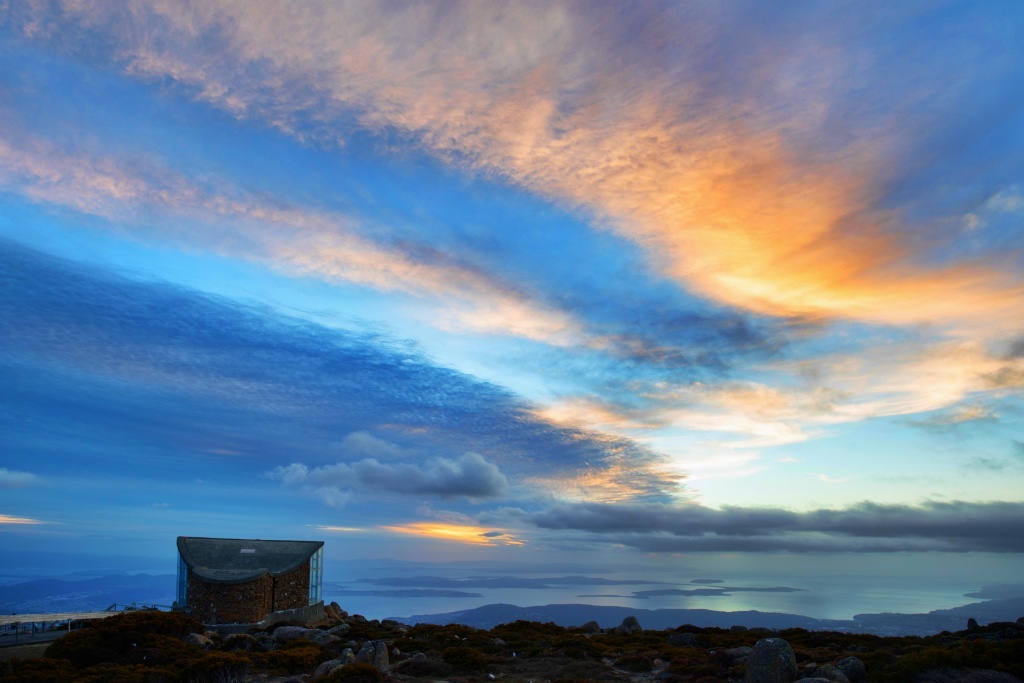
Golden clouds and wispy clouds at Mt. Wellington.
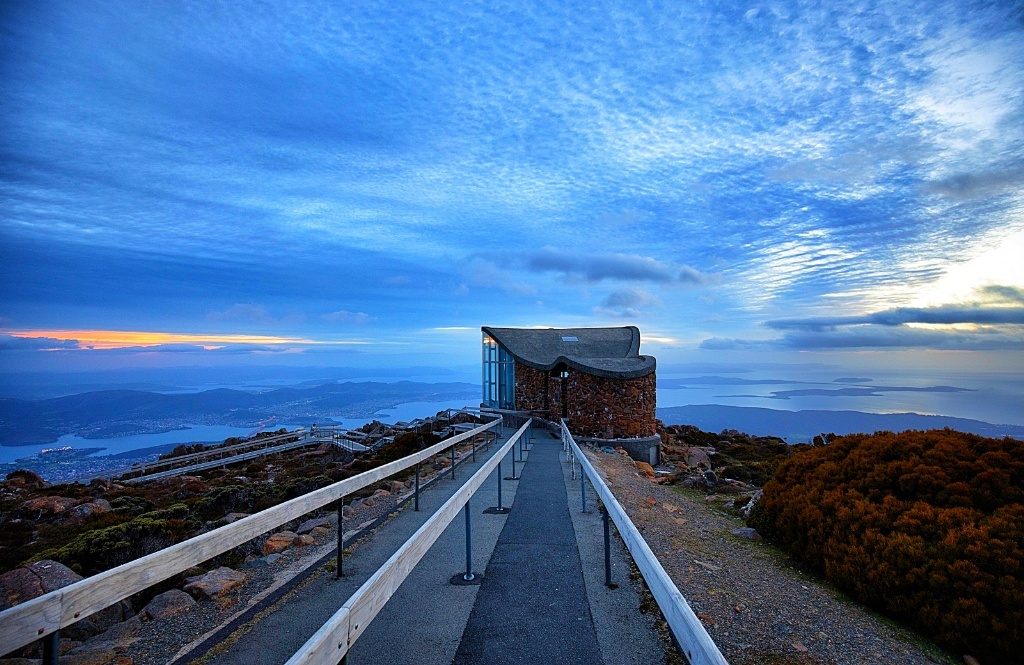
At the Pinnacle lookout point, we were the 2nd to arrive that morning at 5.30am.
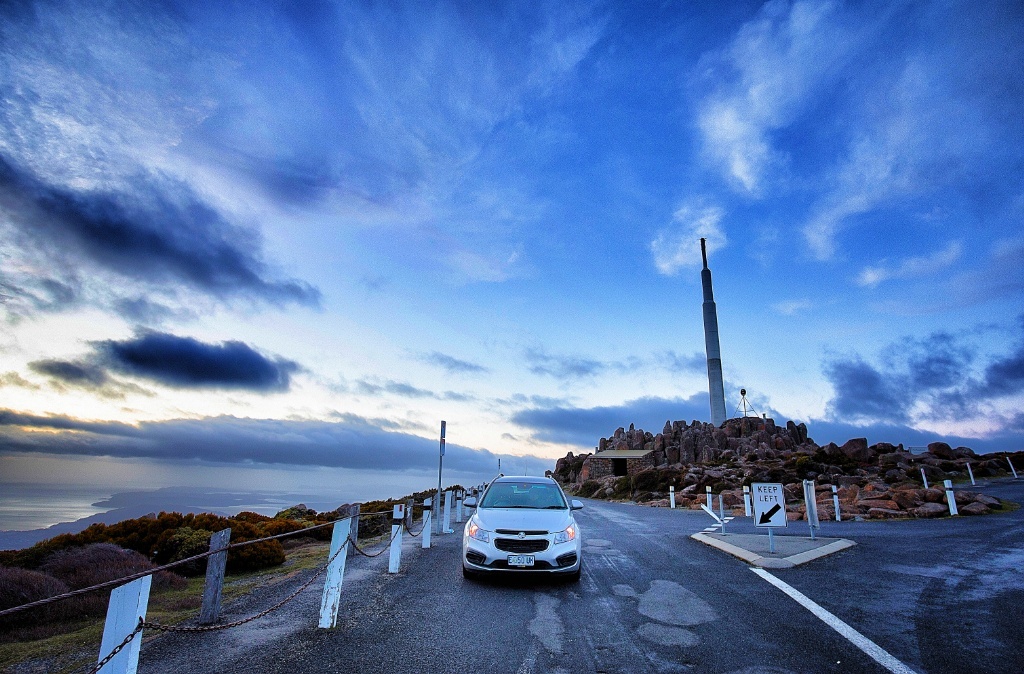
At Mt. Wellington peak. The strong wind really sends in the chill to visitors at the peak.

Check out our car info screen – 2°C at 5.31am. It was 17°C when we leave our hotel at sea level.
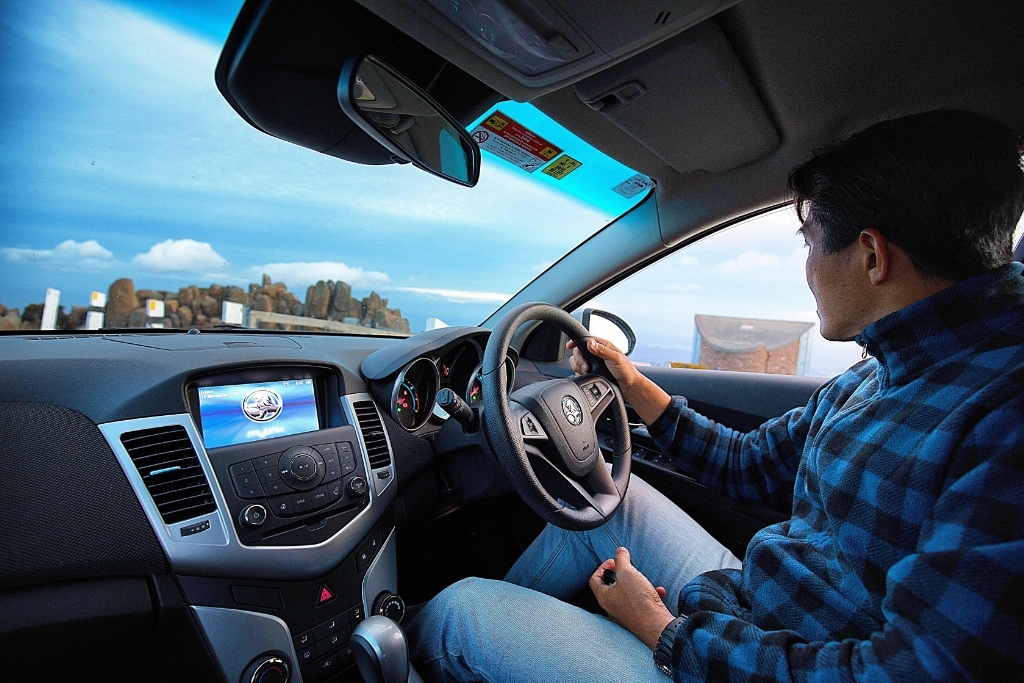
It’s been quite a journey. But as in anywhere, it’s not the destination, but the journey that counts.
This trip was organised by Jetabout Holidays. All pictures used in this travelogue are copyrighted to Jensen Chua Photography and all rights reserved.

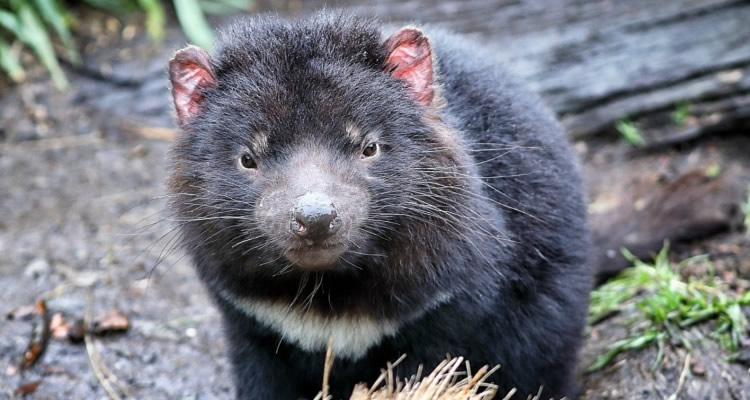
Thanks for your inspiring post on self drive in Tasmania. We are also planning for a similar itinerary as yours. Did you encounter any problems when driving in Tasmania? As we were doing our research we encountered comments on Google map like private or sealed roads quite frequently. Do you know why are all these roads considered sealed or we can’t drive on them? Thank you
Thanks for your message Mandy. I didn’t encounter any issue driving in Tassie. Sealed roads are the normal tarmac roads that u should be driving on. It’s the unsealed roads that u should avoid as it’s essentially dusty mud dried road which can be bumpy and accidents (touch wood) occurring on unsealed are not covered in the rental car insurance. I have not come across private road as the GPS are pretty accurate. Do take note of driving in the night as it is discouraged due to the potential of roadkills (wild animals). Do standby physical maps as certain stretch of the remote areas may not have internet reception. But that said, the roads are generally easy to navigate. I would advise booking your self-drive with Jetabout Holidays as they are the Australian specialist, for peace of mind.
Wow, fantastic blog layout! How long have you been blogging for? you made blogging look easy. The overall look of your web site is wonderful, let alone the content!
Thanks mate 🙂
NdUwQF Informative article, totally what I wanted to find.
News info
I was reading the news and I saw this really interesting info
I just want to say I am very new to blogging and site-building and actually savored you’re web page. Likely I’m going to bookmark your site . You surely come with good articles and reviews. Bless you for sharing with us your webpage.
Hello! I just would like to give a huge thumbs up for the great info you have here on this post. I will be coming back to your blog for more soon.
This is really interesting, You’re a very skilled blogger. I have joined your feed and look forward to seeking more of your great post. Also, I have shared your web site in my social networks!
dept of edu https://studytip.eu/
Your style is very unique compared to other people I have read stuff from. Thanks for posting when you have the opportunity, Guess I’ll just book mark this page.
education online courses https://studytip.eu/
Usually I don’t learn post on blogs, however I wish to say that this write-up very forced me to try and do it! Your writing style has been amazed me. Thanks, quite nice article.|
education tips https://learningtips.eu/
Howdy! I’m at work browsing your blog from my new iphone! Just wanted to say I love reading your blog and look forward to all your posts! Keep up the great work!
dep of education https://educationpoints.eu/
I enjoy what you guys tend to be up too. This kind of clever work and coverage! Keep up the terrific works guys I’ve added you guys to my own blogroll.
best online education https://learningclue.eu/
Hello! I could have sworn I’ve been to your blog before but after browsing through some of the posts I realized it’s new to me. Nonetheless, I’m certainly pleased I discovered it and I’ll be book-marking it and checking back frequently!
best financial plan https://financetip.eu/
Thanks for the support. Sincerely appreciate.
Thanks mate … sincerely appreciated 🙂
hello!,I love your writing very so much! percentage we be in contact more about your post on AOL? I need an expert in this space to solve my problem. May be that’s you! Taking a look ahead to peer you.
Excellent items from you, man. I’ve remember your stuff prior to and you are just too wonderful. I really like what you have got here, really like what you’re stating and the best way by which you assert it. You’re making it entertaining and you continue to care for to keep it smart. I can’t wait to learn far more from you. This is really a wonderful website.|
This is my first time pay a visit at here and i am actually impressed to read all at one place.
Good web site you’ve got here.. It’s difficult to find excellent writing like yours nowadays. I honestly appreciate individuals like you! Take care!!
Wow that was strange. I just wrote an very long comment but after I clicked submit my comment didn’t show up. Grrrr… well I’m not writing all that over again. Anyhow, just wanted to say wonderful blog!
I don’t know whether it’s just me or if perhaps everybody else encountering issues with your blog. It looks like some of the written text in your content are running off the screen. Can somebody else please comment and let me know if this is happening to them too? This could be a problem with my web browser because I’ve had this happen previously. Appreciate it
Hi there, I checked through reading both on my PC and smartphone..I did not encounter any issue as mentioned. I will check with my IT guys for advise.
I’d like to thank you for the efforts you have put in penning this blog. I am hoping to check out the same high-grade content from you in the future as well. In truth, your creative writing abilities has encouraged me to get my own website now 😉
Good post. I’m facing some of these issues as well..